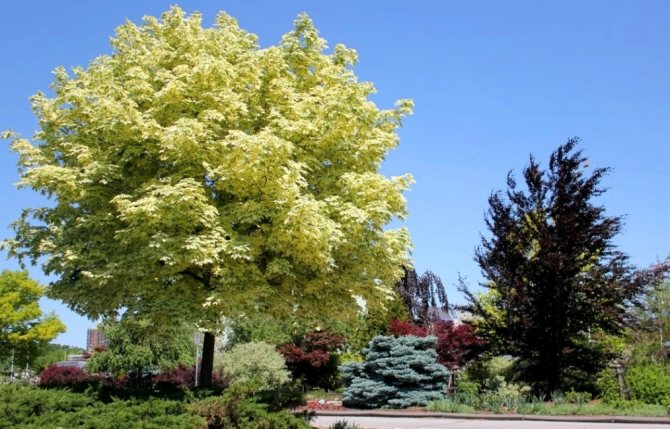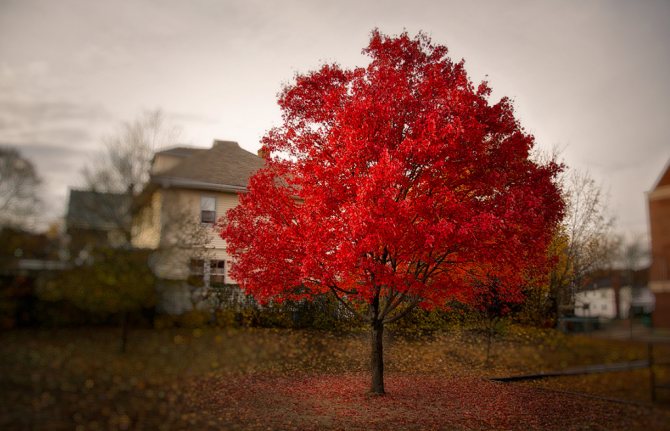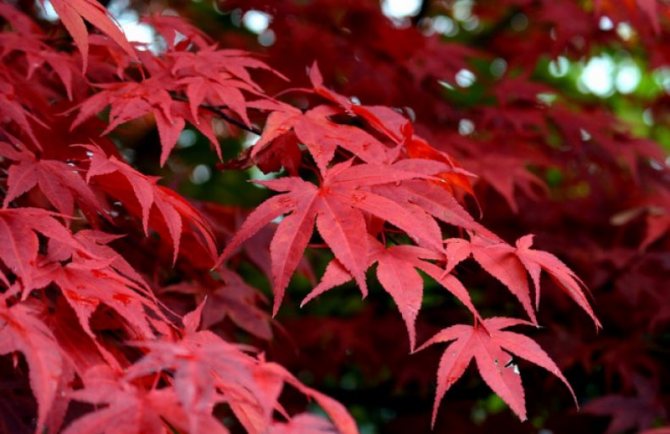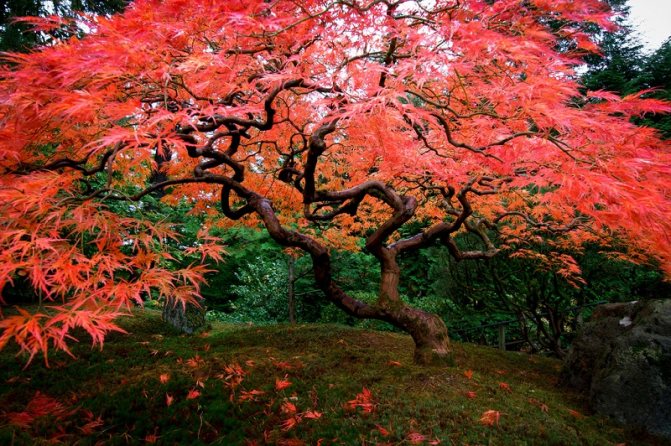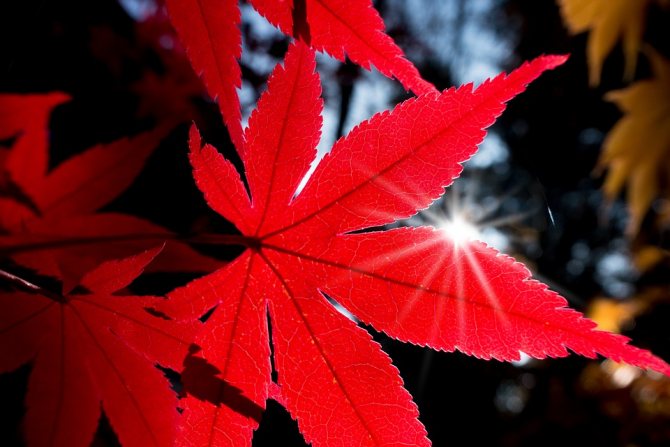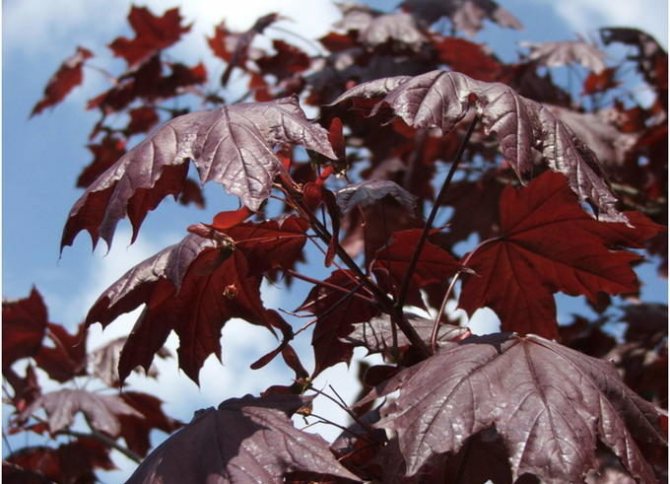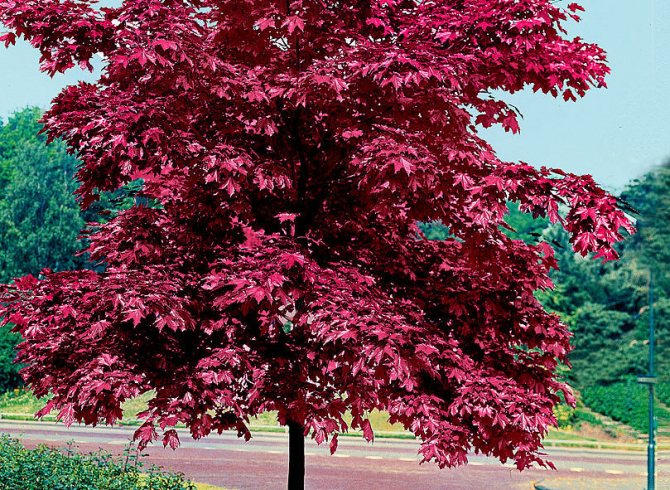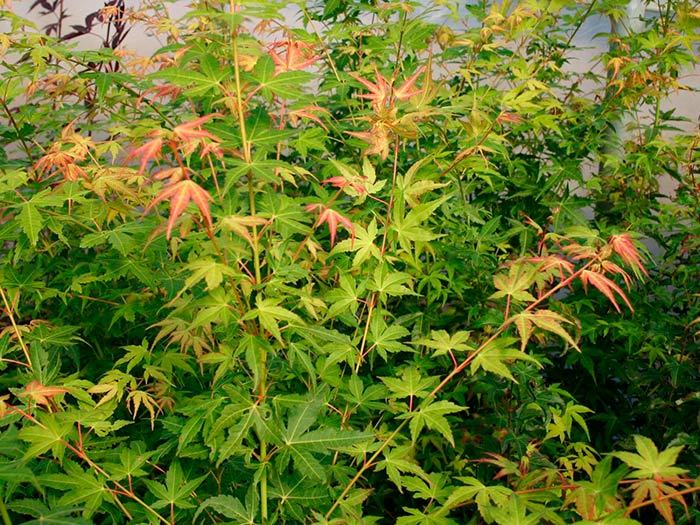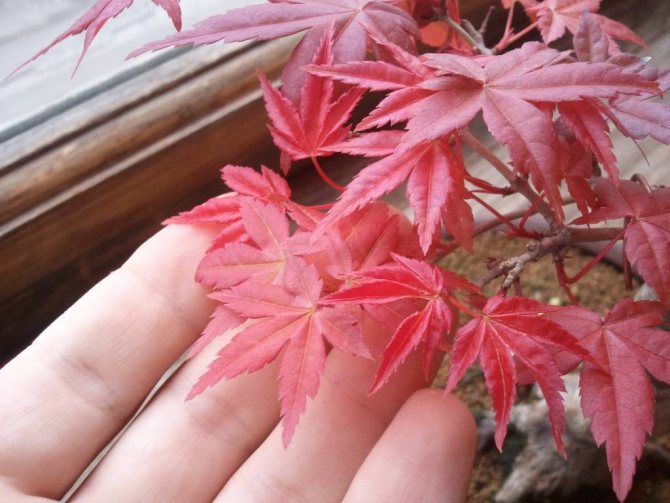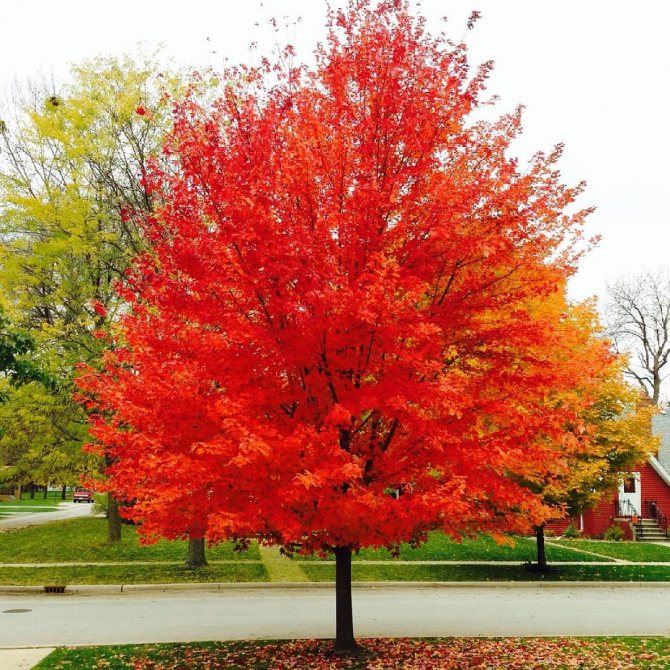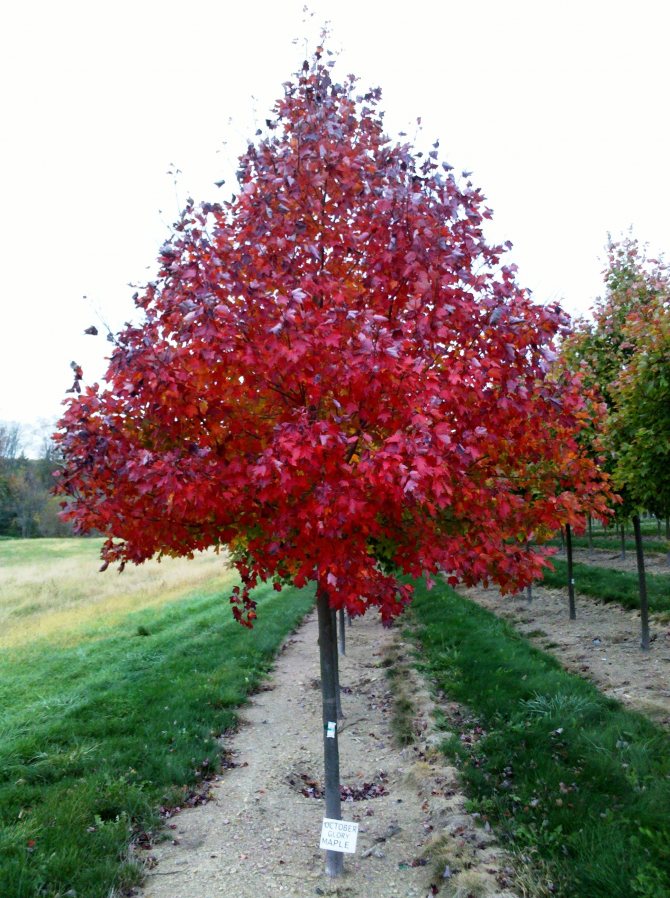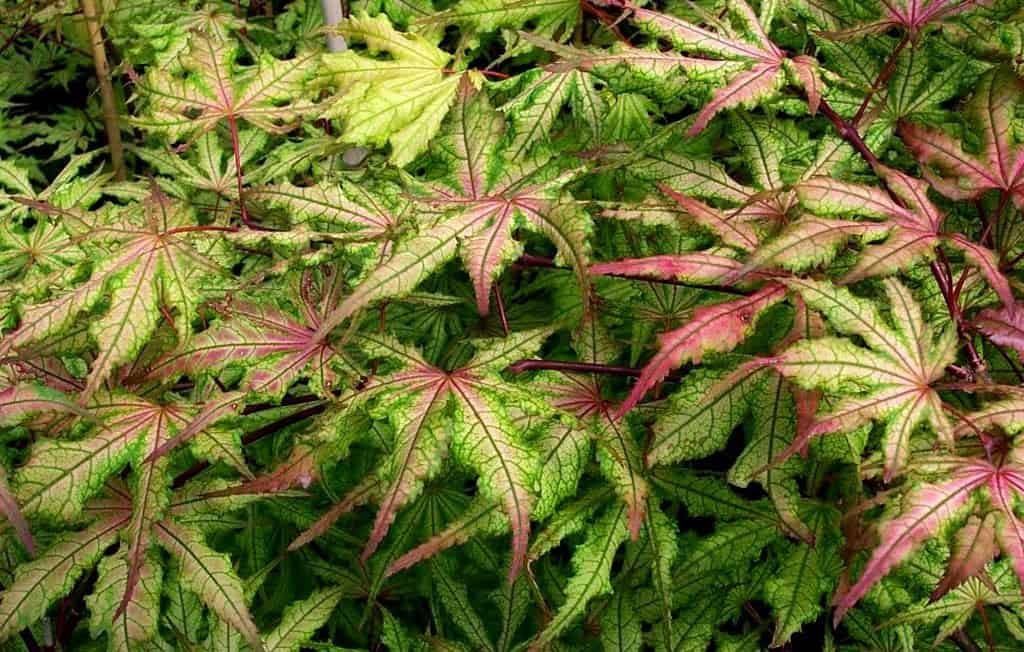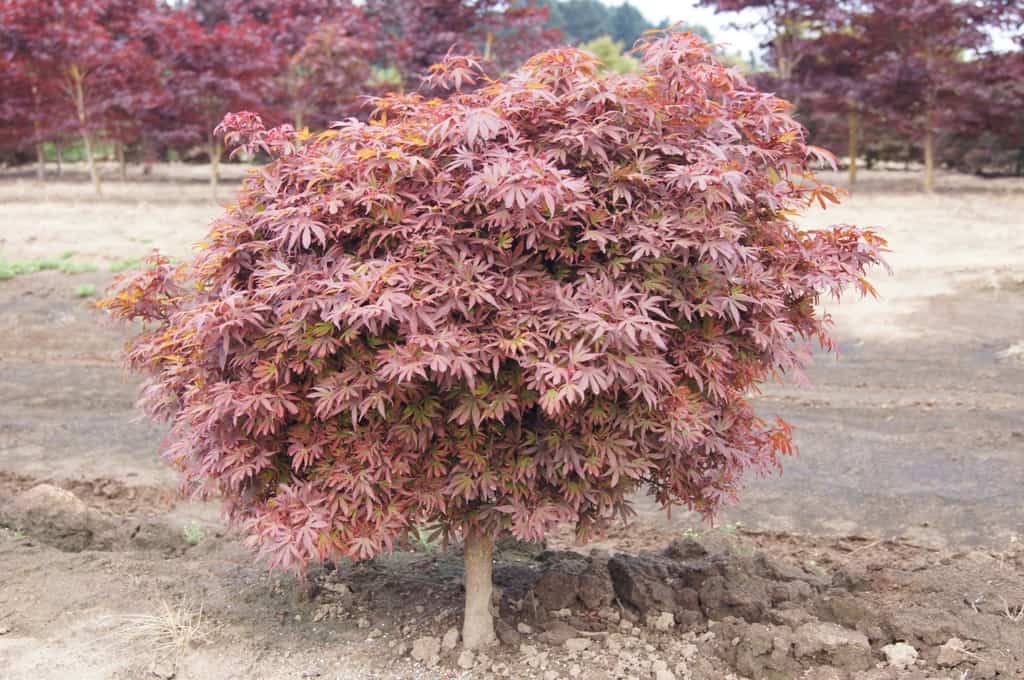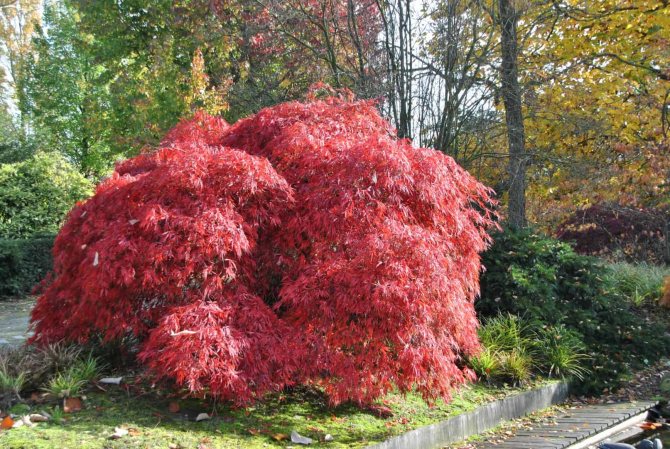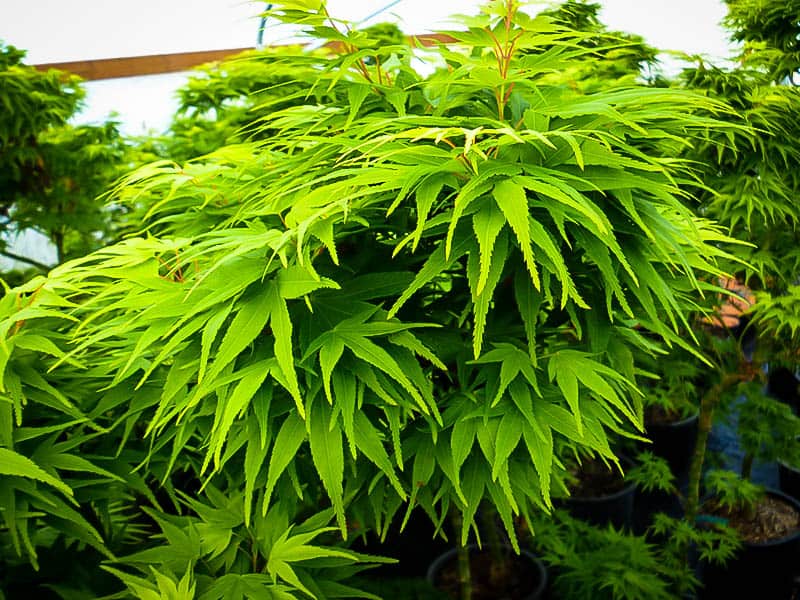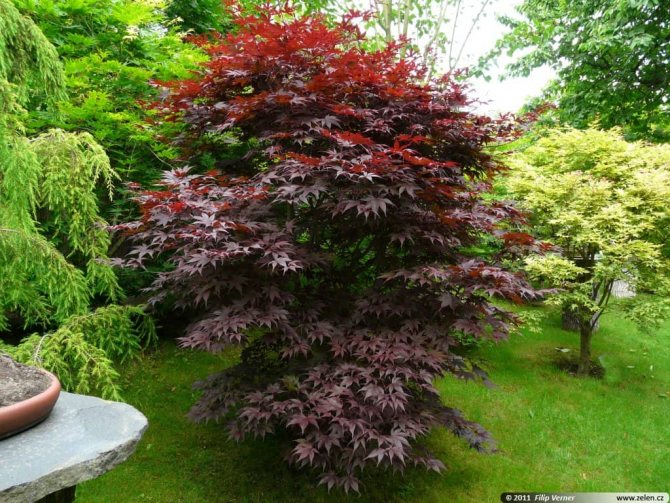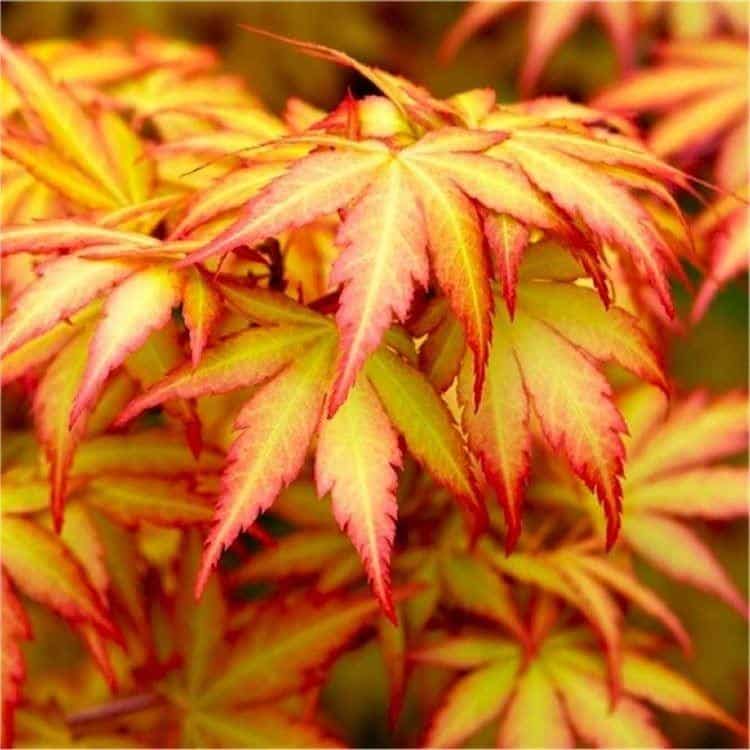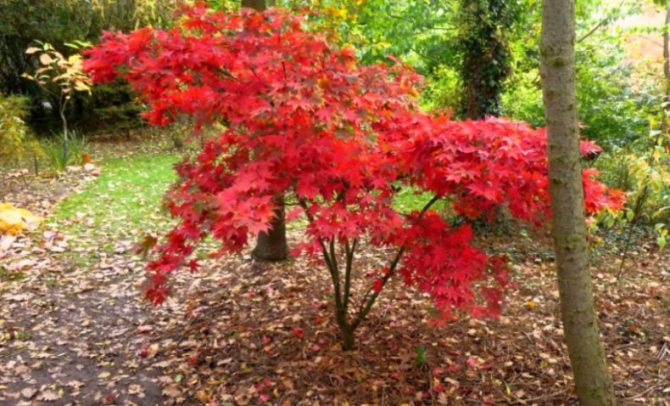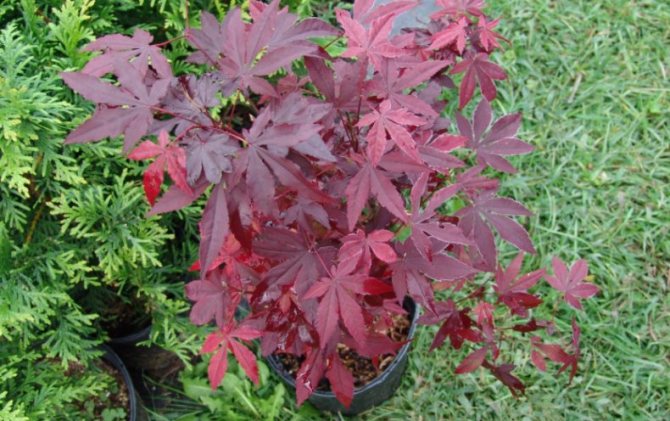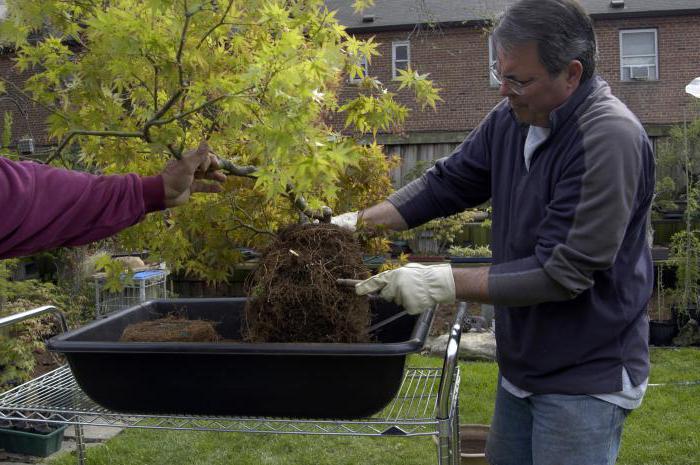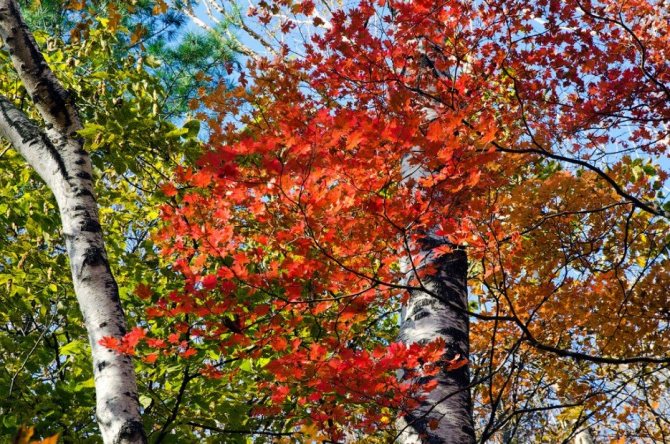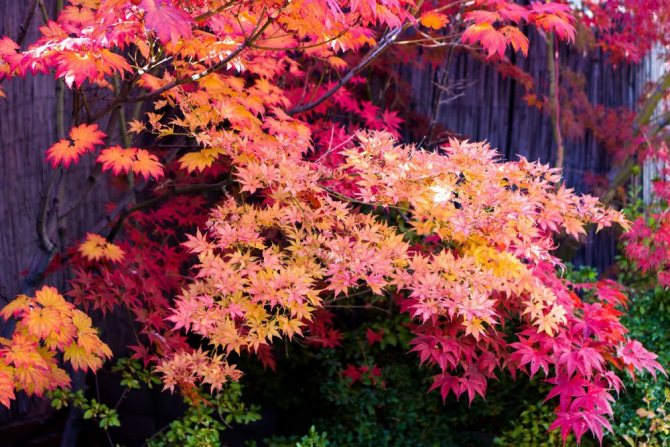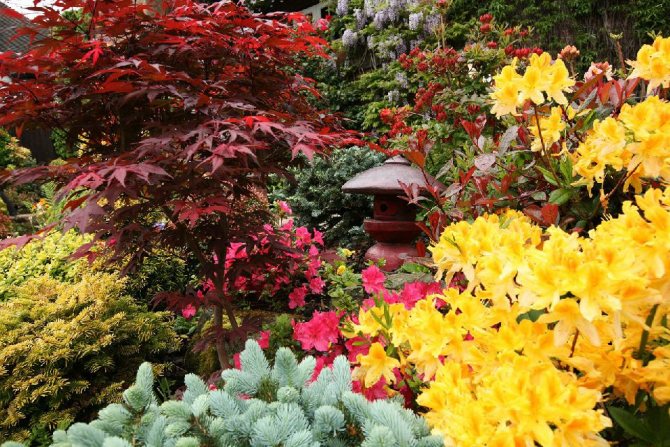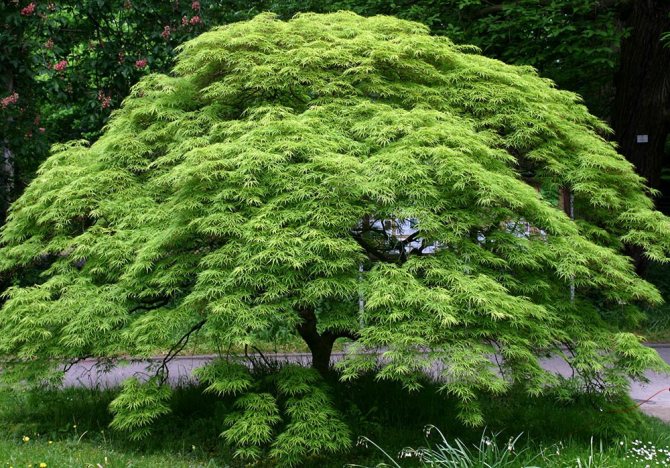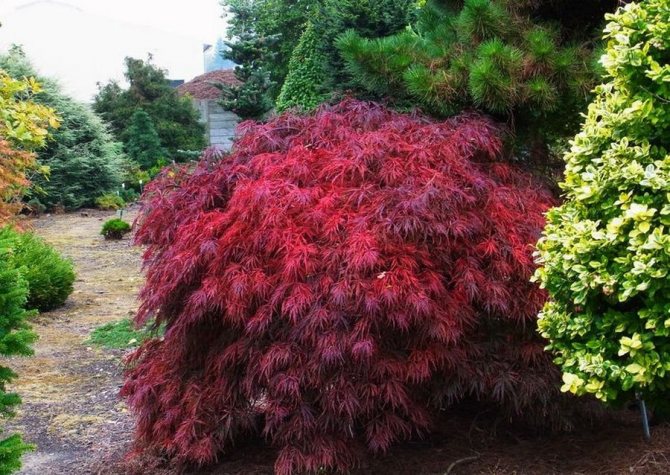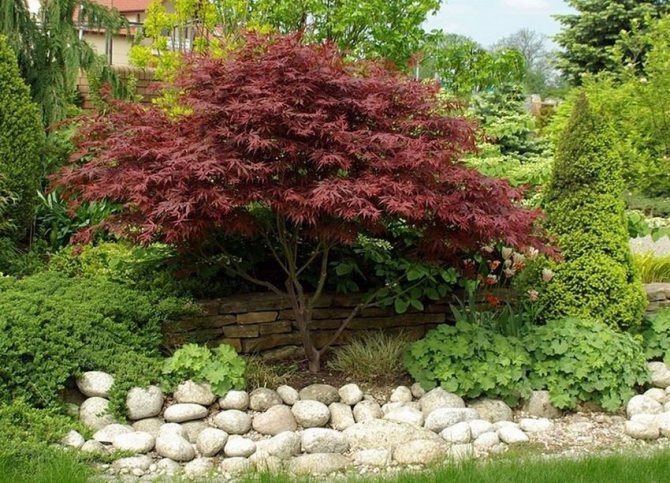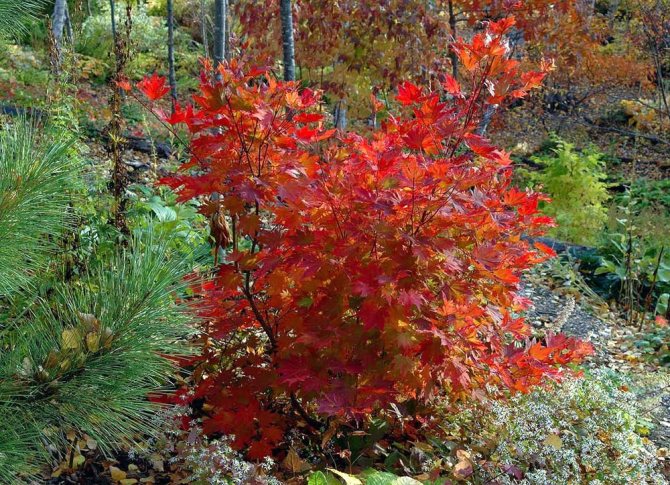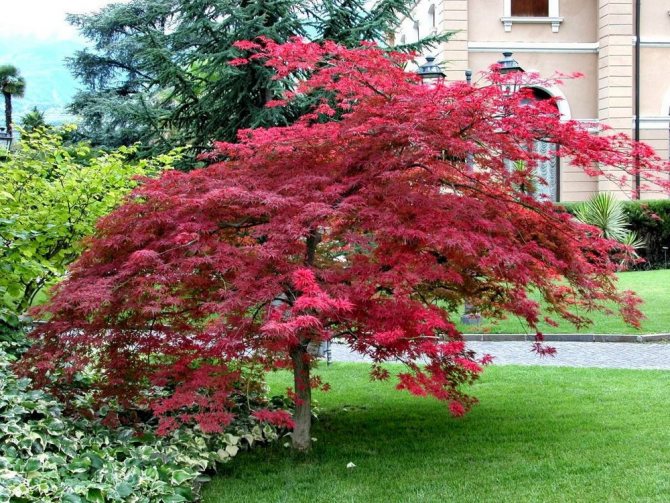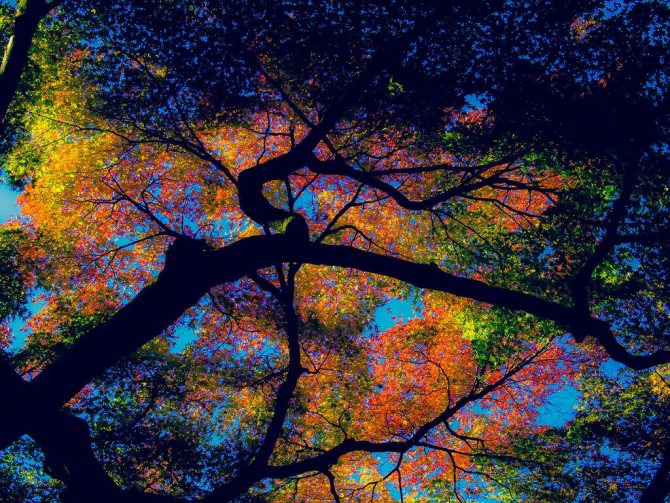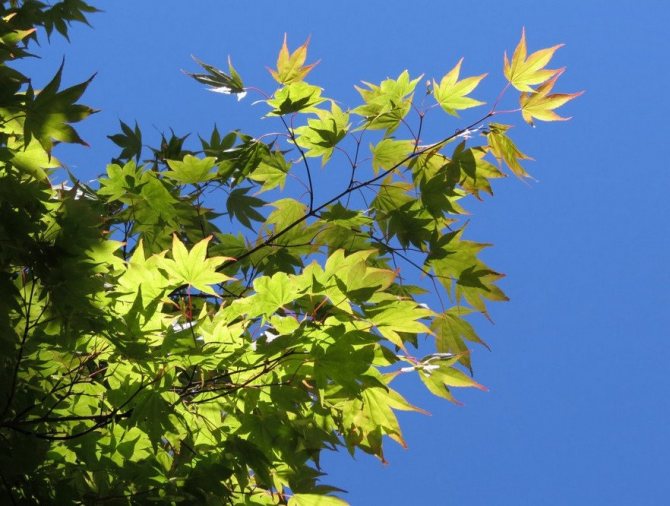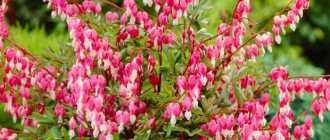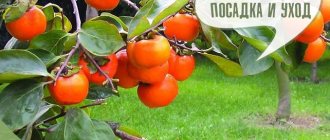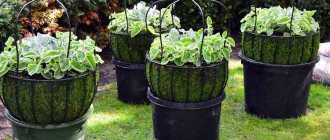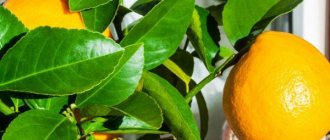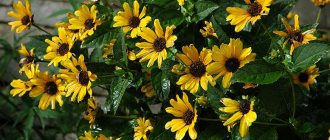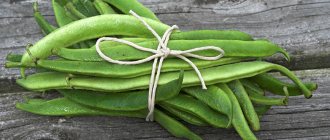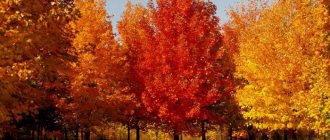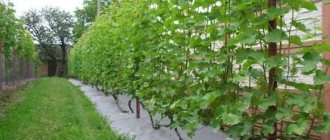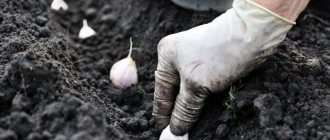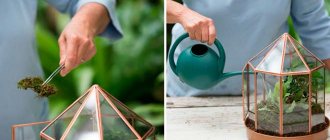03.04.2018 0
3635
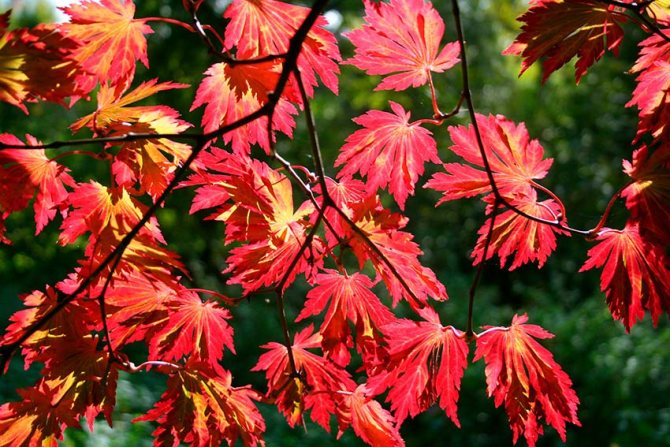
Japanese maple is an amazingly beautiful plant that can fill the garden with bright colors. Depending on the variety, the leaves of the trees have different shades. When planting an ornamental plant and during further care for it, some features should be taken into account. They will help the maple grow lush, beautiful and healthy.
Maple red: characteristics and biological features
The genus Maple (Acer) encompasses over 160 species. It grows without any problems on any soil, except swampy ones. This plant is interesting for its shades of red. Like all plants, maple trees contain chlorophyll, which turns the leaves green in summer. However, in addition to chlorophyll, it contains carotenoids and anthocyanins, which give the leaves different colors: yellow, orange, red, etc.
The crown of the plant has a round or oval shape. Sometimes it looks like a porcini mushroom. The bark has a light silver color that blends harmoniously with red leaves. The leaves of the tree can be three- or five-lobed. This type of tree tolerates our climate well. Red maple has good frost resistance and can withstand up to -20 ºС. The plant does not like constant exposure to direct sunlight and strong moisture.
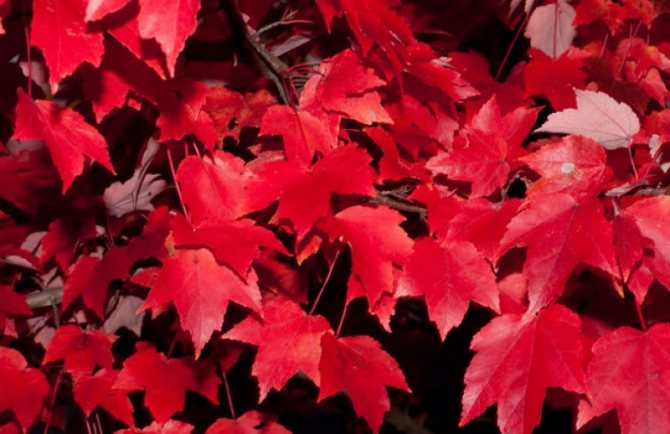

It is recommended to prune and rejuvenate the tree from late August to early December. This should not be done in the spring, since the tree actively absorbs nutrients from the soil, and you can harm it. Vaccination is done in spring or summer by budding.
To the store
We will present you the most unique and amazingly beautiful trees that you will find in a store or nursery.
- "Aconitifolium"
... From spring to late summer, the foliage is bright green. In the autumn, the shade of the tree is yellow-orange. The shape of the leaves resembles deep lobes. - "Aureum"
... It is a variety of finger maple. The crown has a bright yellow tint. The shape of the leaves resembles finely cut lobes. Among these representatives there are trees with colored bark. - "Atropurpurreum"
... The shape of the leaves is the same as in the previous variety. Preferably differs from all other species in its color range. Over the entire season, the crown changes from bright red to black and purple. - "Dissectum"
... The leaves have a semicircular depressed shape. Their color is most often a reddish-purple hue.
The varieties of decorative trees do not end there. You can choose a plant according to your taste preferences, which will harmoniously fit into the landscape of the garden plot.
Popular varieties
The red maple has many varieties. The most popular ones are used as garden or park decorations. Here are some of the varieties:
- "Red Sunset" (Red Sunset) - one of the most popular varieties of this tree. It contains a lot of carotenoids, which is why its leaves are colored bright red in autumn.
- Fassens Black is a large tree with an oval crown. Has a maroon leaf color.
- "Royal Red" (Royal Red) - at the very beginning of the growing season, the crown is bright red, which fades over time.
- "Drummondi" (Drummondii) - when blooming, the color of the leaf is pink, over time it becomes light green.
- Elsrijk is a field plant with a wide oval crown, used for landscaping park areas.
Red maple trees can be grown like a bonsai tree, although the process is a lot of work. It is worth noting that various varieties of maple have been cultivated in Japan for a long time using this technology, which, among other things, have beautiful exotic colors. Here is some of them:
- blue or blue;
- crimson red;
- light purple.
The essence of this technique is that the root is not allowed to grow, and the crown is greatly shortened, almost to the size of an indoor flower. After that, the plant becomes a real mini-tree.
Japanese maples and their best varieties
Japanese maples are types of maples, united by origin: they all come from the alluring and mysterious Land of the Rising Sun. Endemics and their cultivars of this group are very popular and are considered the most demanded representatives of the genus, distinguished by the extraordinary picturesque silhouette and beauty of the carved foliage. These include:
- actually Japanese maple
(Acer japonicum), which, due to its low frost resistance, can be grown only in the south or as a tub - a very beautiful plant with deeply dissected graceful leaves and a complex color from green to cherry and burgundy (decorative forms - large and small-leaved, golden, aconitol);
- became legendary Fan maple
(Acer palmatum) and its many varieties;
- more rare, but no less beautiful Shirasawa maple
(Acer shirasawanum) with a height of only one and a half meters, in which leaves with a small section are distinguished by a larger plate width (classic varieties are colored yellow and orange, 'Aureum' shape - with an original border along the edge of the leaves).
Almost all maples from Japan presented in the assortment of horticultural centers are varietal plants representing an assortment of fan maples and their hybrid and selective forms. The basic species of the other two oriental plants are much less common and, as a rule, are significantly inferior to the cultivated forms of the fan maple in the choice of different colors and forms of cultivation. It is possible to understand the names of individual varieties without problems only if you speak Japanese: each name of the variety of the fan maple denotes a key feature of the plant, which is sometimes reflected in the English decoding in the catalogs of large companies.
Fan maples such as:
- openwork dark red "Bloodgood" with a delightful inky black shade of leaves and bright fruits, capable of exhibiting an unusual dark color even in the shade; - bright scarlet maple "Beni Kava" with light leaves and a very bright scarlet shade of the bark; - variety "Orangeola", which also has a beautiful spring dress of almost yellow young foliage; - variety "Katsura" with reddish young leaves and bright "curly" green summer decoration, growing beautifully in tubs; - variety with scarlet autumn foliage "Osakazuki"; - the longline variety "Nicholsonii" with a height of 2 to 3 meters with an autumn crown showing all shades of brick red; - multi-stemmed and very picturesque maples with powerful curved branches "Aconitifolium" with a glowing dark red dress, decorated with occasional splashes of kraplak and brick; - three - four meter "Dissectum" with elongated coniferous leaves and a bright orange-yellow color with occasional blotches of other tones; - two-meter tall with a very wide spreading crown, burgundy main and orange autumn color fan maple variety "Dissectum Garnet"; - compact and more dense stocky one and a half meter variety "Mikawa yatsubusa" with thin needle-shaped leaf lobes and a dress that transforms from acrylic green to orange-scarlet; - a little more than a meter wide spreading maple "Shino Buga Oka" with very deeply dissected leaves and color change from bright green to yellow-orange.
Choosing a place for the red maple
The tree grows in almost any soil. Red maple grows well on our black soil in cold and snowy winters. This plant will blend harmoniously with perennial conifers. Under it, you can plant bright late flowers, which will turn red in the fall along with the leaves of a maple tree.
Breeders have bred some decorative maple varieties that reach a height of no more than one and a half meters. They are planted in pots and decorate balconies and terraces. When planting such a tree, the land must be bred with peat and fertilized at the same time. These plants need to be watered regularly as they may lose their decorative properties.
Use in garden design and selection of partners
Japanese maples, especially of rare varieties, are quite expensive and valuable plants, they always and everywhere play the role of the main accents and important points of attraction of the eye. They are placed only in such a way as to maximally reveal the beauty of the plant itself. Maples of Japanese varieties are always planted in the best locations of the garden, near the most advantageous and structurally important objects. Most often they can be found near a terrace or pond, in front gardens, rock gardens, rock gardens and rockeries, near a large recreation area or in a landscape group that revives large spaces of lawns. Such maples are not afraid of solo parties, and the neighborhood of other plants.
Finding companions for maples is not an easy task. Such stars of any landscape need a worthy accompaniment - bright, but still less catchy than the woody ones themselves, corresponding to the "level" of maples in texture, palette, and luxury of details.
One of the typical landscapes of the Land of the Rising Sun is a quiet and secluded corner for relaxation under the shade of a maple tree, the beauty of which is "supported" by the pillows of blooming chrysanthemums. Laconic, restrained, but surprisingly picturesque, the duo remains today an ideal example of the selection of classic companions for decorating any garden. It also looks very good under Japanese maples and rootstock of Epimedium or Hakonechloa, ferns, Volzhanka, and sedge (especially deciduous varieties, which also explode with bright fireworks of leaf transformation in autumn). You can always limit yourself to a minimalistic design: decorative stone chips in the near-trunk zone and balancing the crown with one or two plants or large boulders around the perimeter. Of the large - equivalent - partners, maples are better combined with representatives of the conifer family.
Maple seedlings planting process
Maple trees are best planted in partial shade, but they can also be planted in open areas. The plant does not like constant exposure to sunlight, but it still needs it. Red maple is planted in spring, best in early to mid-April. When planting a seedling, the root collar should be at ground level or protrude no more than 5 cm. With a large protrusion, the roots of the tree will begin to dry out as it grows.
If you plant a plant near groundwater, then drainage must be done so that the root system does not start to rot due to high humidity. Put some humus and peat in the hole along with the root of the tree, pour twenty liters of water. It is also advised to add a little nitroammophoska (about 150 g per seedling). The optimum acidity of the soil for the normal growth of an ornamental tree should be pH = 6.0-7.5.
Indoor tree
A special dwarf variety is grown at home. Japanese maple on the windowsill has a positive effect on the apartment. Namely:
- humidifies the air;
- increases the amount of oxygen in your apartment;
- from spring to autumn it will delight with its flowering.
Despite the fact that the plant is easy to plant and care for, it is constantly attacked by various pests, for example:
- whitefly;
- spider mite;
For the treatment and prevention of diseases, use this solution: dissolve 1 mg of decis in a liter of water. Stir the mixture thoroughly and spray it on your Japanese Dwarf Maple.
How to care for young seedlings
Red maple requires special care. While the seedlings are young and immature, they require constant feeding with mineral fertilizers.Every spring urea (40-45 g), potassium salts (15-25 g), superphosphates (30-50 g) should be added. In the summer, the soil around the tree must be loosened and at the same time 100-120 mg of the Kemira preparation should be applied once a season.
Seedlings are watered about once every two weeks - 15-20 liters of warm water at the root. The plant tolerates dry soil well, but at the same time it can lose its decorative properties.
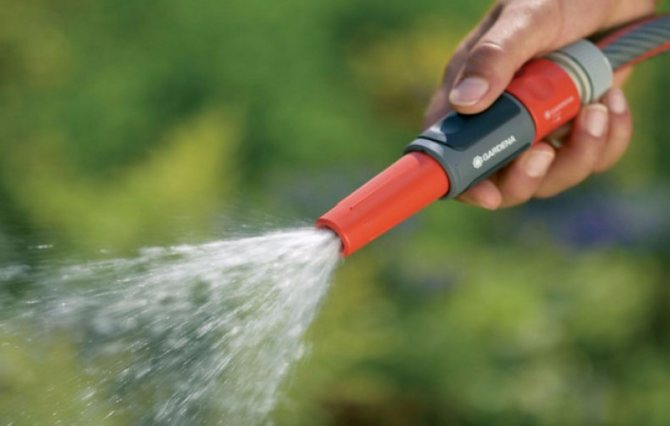

In winter, red maple seedlings should be covered with spruce branches directly under the root, especially if there is insufficient snowfall. In severe frosts, the root of a young plant is very sensitive and requires protection. It is also necessary to wrap the tree trunk with thick burlap. If the shoots freeze, they must be removed. In the spring, with normal maintenance, the tree will grow again.
Growing
Although the procedure for planting a Japanese maple seedling is simple, however, it requires knowledge of some nuances. Let's talk about these nuances in more detail.
To correctly plant a plant, you must prepare in advance:
- the seedling itself: healthy and strong;
- compost and peat for fertilization.
First, you should dig a hole: its parameters should be approximately twice the span of the plant's roots. If the seedling was bought in a pot, then it is necessary to carefully remove it from this container. Untangle the roots of the plant: also very carefully, without jerking.
Add peat and compost to the prepared hole. Place the seedling in the hole, sprinkle with soil on top, tamp.
Video: planting a tree
In the video - planting a Japanese maple:
Form small bumps of earth around the seedling along the diameter of the root circle. This will make it easier to water the plant as the water won't drain.
Immediately after planting the maple, or, water the seedling so that the roots take root faster. If the summer is very hot, the seedling will need to be watered more often and more abundantly.
Next spring, it is necessary to lay a mulching layer of earth mixed with rotten fallen leaves on top of the root circle of the plant. This layer will help moisture stay in the root circle longer, and will also protect the soil around the seedling from weeds.
What are the plants for hedges, and how they look, this information will help to understand:
How to make a willow hedge with your own hands, will help you understand the photo
How to care for mature trees
When the plant has grown and is strong enough, caring for it does not require much effort. Red maple after planting and up to four years of age requires maintenance in terms of fertilizers. After that, minerals should be applied to the soil no more than once every two years. Many ornamental plants are adapted to grow in the wild, such as in the forest, where no one cares for them. And at the same time, trees grow normally for 100-150 years. But a decorative tree needs care in order for it to remain beautiful and vibrant.
To do this, cut off some branches, especially dried ones. You also need to cut down all the branches that interfere with growth. Experts recommend not cutting off the shoots, the maple plant should be branched. The tree can be given a beautiful rounded crown. The ideal season for pruning wood is August-December. If these time frames are not observed, the plant may begin to "cry".
Read also: How the healing properties of scumpia are used in traditional medicine: benefits and harms
Landing specifics
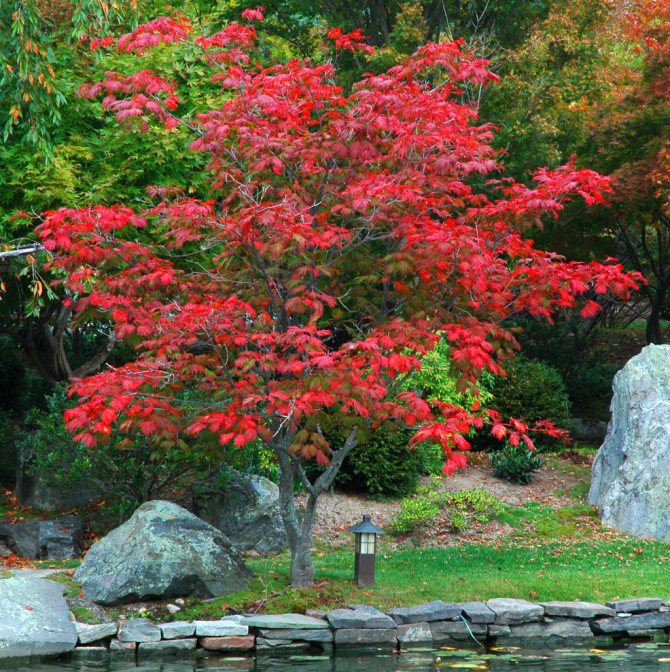

Even experienced gardeners do not always risk acquiring capricious representatives of the Asian flora, believing that such plants are unsuitable for growing in harsh climates. Nevertheless, it is quite possible to grow a red maple in your country house - it is only important to take into account some of the nuances.
First, for planting a tree, they choose a place where the upper fertile layer of the earth will be sufficiently moistened. It is important that the soil does not contain a large amount of stagnant moisture, as this adversely affects the seedlings.
Secondly, you should take care of wind protection.This is not to say that maple drafts are terrible, but in a quiet and comfortable place, the growth rate of a woody plant will increase significantly.
There are no special requirements for lighting. It goes without saying that a completely dark place is an unsuitable environment for the full development of trees and shrubs. In addition, we must not forget that natural processes of photosynthesis cannot proceed without light. In addition to this, the sun's rays reflecting off the variegated maple leaves create a stunning picture.
As already mentioned, the Asian woody plant prefers moist soil, but does not like excessive accumulation of water. In this regard, experienced gardeners strongly recommend making high-quality drainage for the root system of the plant.
Almost any type of fertile soil with a high humus content is suitable for planting seedlings, except for too alkaline soil.
The technological process of planting a red maple tree consists of several sequential steps:
- A pit is prepared, which should be at least twice as wide and deeper than the root ball.
- At the seedling removed from the container, first gently loosen the soil between the root shoots, and then straighten the roots.
- The soil soaked with fertilizers is poured into the pit. The maple should be placed in the pit at the same depth as it was in the container.
- Having covered the hole with soil and compost, it is carefully tamped from above.
- A small mound of earth is formed around the planting site to prevent water from spreading when watering.
Features of growing pomegranate and caring for it at home
Use of red maple
Red maple, in addition to its decorative properties, has many more useful ecological and economic purposes. In some countries, purple paint is made from the bark of this tree. In addition, the bark of the plant is rich in tannin and sugars.
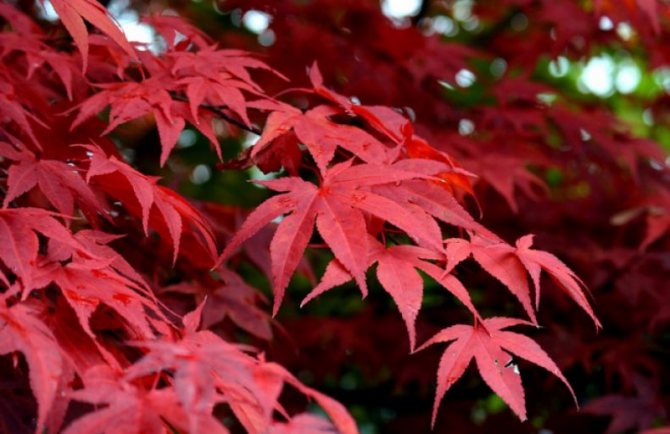

Red maple leaves contain a lot of vitamin C, they are used as food for sheep and goats. During the flowering period, many bees gather near the tree, which actively collect nectar.
In the spring, even before the buds swell, juice can be collected from the tree. Sugar can be extracted from pure and clear juice when properly processed. The juice flows actively during the day, at night this process stops. It is worth noting that when the buds swell, the juice becomes cloudy and greenish. In this form, it is no longer suitable for making sugar. In the United States, maple sap is used to make delicious and healthy syrups. And in Canada, this plant is a national symbol; its leaf is depicted on the country's flag.
And yet, many people grow red maple for decorative purposes. With proper care of the tree, it becomes an adornment of any suburban area. Crimson leaves bring color to every fall day. If you have read our article and learned how to grow a red maple, then you should not delay planting it. Different varieties of red maple can be grown both in pots and outdoors. In any case, this is an excellent decorative decoration.
Room care
The procedure should include the following points:
- thorough watering from spring to late autumn;
- in winter, it is better to reduce the moisture of the plant in a pot by half;
- fertilization of the tree with complex preparations is allowed;
- Transplant the plant into a larger container every two years.
You met with street and domestic Japanese maple. Now you can grow a decorative ornament in your garden, which you can take care of according to all recommendations.
Description of the species
The red maple, in other words, the red-leaved maple, is one of more than 150 varieties of crops that belongs to the maple family.The plant comes from Southeast Asia, the plant gained great popularity in Japan, where it grows not only in open soil, but is also successfully used in the cultivation of potted plants, and is also grown in special pots for decorating veranda, terraces and balconies.
The general name red maple means several varieties of maple trees with a special color of leaves at once. The most popular of them are:
- Japanese red maple;
- maple Shirasavi;
- palm-shaped (a tree with palm-type leaves), or fan-shaped.
The tree owes its unusual beauty and decorativeness to the colors of the leaves to the special biochemical composition that is characteristic of these trees. In addition to chlorophyll, which provides the green coloring of the plant, maple also has a large number of carotenoids, which in most cases give red, yellow and orange colors on the leaves. The cell sap of plants contains a large amount of anthocyanins, which color the foliage in purple, as well as a carmine color, which harmonizes beautifully with the gray color of the tree bark.
The crown of red-leaved maples, as is often the case, is found in a round or oval shape, in some cases you can find trees in the form of a mushroom. Finger-shaped cut leaves are more like lace gloves. In this culture, absolutely everything is considered decorative - foliage, which changes its color and saturation from spring to autumn, as well as silver-gray bark and thin twigs with leaves fallen in winter.
An ornamental plant is considered very hardy, but does not like direct sunlight, as well as drafts and low temperatures: below -15 degrees Celsius. The best place to grow red maple is a wind-protected area in the garden with mosaic lighting.
Planting a seedling
The tree attracts attention with its orange or red crown and grayish bark of the trunk. There are several varieties of plants, seedlings are chosen taking into account the size of their own plot.
Japanese maple has a peculiar color of foliage
Purchase young maple in a container. So the roots of the tree will not suffer during planting, and the soil familiar to the plant will increase the chances of survival. Choose a seedling up to a year old, with healthy leaves and no obvious damage.
First of all, find a place on the site suitable for maple, without drafts and with good lighting. The presence of large trees nearby is undesirable.
The simple landing rules are as follows:
- Prepare a 30 cm depression in the soil.
- The tree does not like waterlogging, so form a drainage layer from dropouts or small stones 5 cm thick.
- Moisten the soil, remove the seedling from the container and place it in the hole.
- Cover the top with soil containing peat.
- Water the young tree, spray the leaves with water.
Maple is undemanding to the composition of the soil, the main condition is the presence of humus. An alkaline environment is categorically unsuitable for a plant. Further watering is often organized in small amounts.
How to plant a plant
It is worth planting plants in mountain-type gardens, where they can look beautiful with perennial coniferous crops. At the foot of a tall culture, which can reach a height of four to five meters, perennial flowers should be planted that will not need special lighting. The umbrella-type crown is able to create a cozy shade in the very corner for relaxation, it looks beautiful with plants that are common in the middle zone of the country.
- Such crops with red leaves look very attractive in single planting types, as well as in limited plantings in groups. When planting, it is worth maintaining a certain distance between seedlings from one and a half to three and a half meters. The pit should be prepared in advance with a depth of fifty to seventy centimeters.If planting takes place in a highly swampy area, then it is imperative to create a good drainage layer. The well should be filled with water and a complex of organic fertilizers should be added to it.
- Some varieties of maple with red leaves were bred by breeders in order to grow in special tubs or containers. Such crops do not exceed one and a half meters in height. Maple should be planted in a mixture of equal amounts of compost, peat, and turf. The culture that is grown in the pot itself does not like a lot of moisture. Watering red maples, and those trees that grow in tubs, as well as those growing in open ground, must be combined with special fertilizers. The regularity of watering the plant will directly depend on the growing area, growing conditions and outdoor weather.
- If the plant lacks moisture, then it does not die, but it will lose its decorative effect.
When caring for a maple, you should pay more attention to its pruning. It will only be enough that you will from time to time cut down damaged branches, as well as dry bitches. It is worthwhile to seal all damage and deformations on the structure of the tree bark in a timely manner with a garden pitch in order to protect the plant from infection and various parasites.
But the plant will have a special decorative effect if it is in the hands of a skilled and professional gardener. Trees after shearing acquire a very beautiful and graceful appearance, and in combination with the beautiful color of the foliage, this can get an attractive result.
Read also: Team hedgehog
We care correctly
The basic care of the plant includes the following points, the fulfillment of which is mandatory:
- Although the tree loves well-moistened soil, it should not be constantly damp. This can rot the roots.
- If your site is small, no problem. The bush can take root on any plots of land, the lighting of which may not be suitable for the variety.
- Maples are not afraid of drafts.
- Always prune the tree every spring. This procedure in the first years of the plant's life will help it to acquire the correct shape. In the subsequent period, you can simply remove dry and diseased branches.
- Additional watering is required once a month. For one root, about 15 liters of water.
- In August, it is recommended to stop all feeding.
Remember!
Additional watering does not in any way cancel out on-demand humidification.
The quality of the tree will directly depend on the seed.
Reproduction of culture
Red maple, like a large number of other plants, should be propagated by cuttings or seeds.
When choosing a method for propagating a culture with the help of cuttings, they should be harvested and cut off in the fall, digging into a special hole before spring comes. In spring, overwintered cuttings should be transplanted into pots with light soil mixed with sand.
If you grow red-leaved maple from seeds, then it is worth collecting "helicopters" with seeds and keeping them in the winter at a special temperature regime of 0- -3 degrees Celsius. In spring, before the process of planting seeds, they should be soaked, and when a sprout begins to emerge from them, sow into a hole with a total depth of up to five centimeters. In the summer, sprouted seeds should be shaded with high quality, as well as moderate watering. At the moment when the seedlings grow to a mark of fifty to eighty centimeters, they should be transplanted to a permanent growing place.
Reproduction of red maple
In autumn, cuttings are cut for vegetative propagation (20 cm). For the winter they are added in drops, and in the spring they are rooted in containers or pots. Fill containers with light soil, be sure to mix with sand. In the spring, buds or cuttings of decorative cultivars are grafted onto more winter-hardy and fast-growing varieties of the same species (or closely related ones).For seed propagation, lionfish are harvested and sown in the soil in the fall. But it is better to create conditions for them that resemble stratification in nature, which occurs in winter at a temperature of about 3 ° C. In the spring, the seeds are soaked before sowing, and when they hatch, they are sown in the garden to a depth of 4 cm. In the summer, in the heat, the seedlings need to be shaded. Seedlings that have reached 50–80 cm can be transplanted to a permanent place.
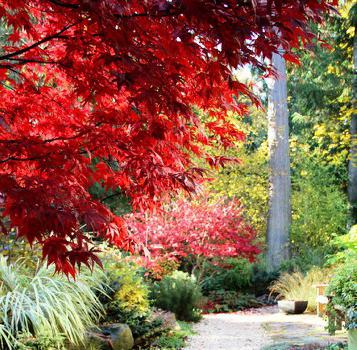

Maple with openwork crown
The Japanese maple can be attributed to the Salindovye family, and it belongs to the Maple genus. The main place of growth of the plant is the forests of Southeast Asia. Japanese clover is able to surprise others with a variety of forms; in the Land of the Rising Sun, it has been bred for many centuries. Now breeders are actively breeding an increasing number of varieties of this popular ornamental tree.
- In the summer, the golden foliage from the Shirasawa maple can attract the surrounding gardens and terraces; in the autumn, it acquires a bright orange color. The Dutch varieties of the fan maple are covered with glossy dark red leaves, which, before falling to the ground, begin to change their hue to orange-red. An attractive crown on a plant takes on a large number of bright colors in good light and in shade conditions.
- The palm maple is compact in size. The fan plant is able to show others all its richness of purple, orange, and also pink shades. The main place of origin of such a plant is considered to be the forests of Japan, Korea, as well as the territory of Eastern China. Under natural growing conditions, young trees can grow up to 8-10 meters. The crown over time begins to acquire a rounded appearance or mushroom shape. Young shoots of crops are covered with colored skin.
In spring, the leaves begin to change their color to red, and in summer they actively change their color, in autumn they acquire a purple hue. The flowers of the culture are collected in bright and loose inflorescences. The shape of lionfish can be very different among the different varieties of fan maple. The culture is thermophilic, and is also particularly demanding for feeding and moistening the soil, but the culture may not withstand a large amount of moisture and waterlogging.
An outdoor temperature less than -15 degrees Celsius can lead to a decrease in soil fertility and damage to the rhizomes of the plant. The breeding process can be carried out with seeds, which should be sown immediately after harvest. The most common types of red maple are: pink-edged, crimson, purple dissected and other varieties.
Description and features
From the name of the plant, it is easy to guess that his homeland is the country of samurai and geisha... The tree grows not only in the humid forests of Japan, but also in the southern part of the Korean Peninsula. Being a thermophilic tree, Japanese maple does not particularly favor the geographic latitudes of Russia, with the exception of the South Kuril region of the Sakhalin region. This was the reason that the plant was once listed in the Red Book of the Russian Federation.
The carved leaves of red, purple and bright orange color, as well as the beautiful structure of the crown, make the Japanese maple the most spectacular decorative tree. In the warm season, it delights with the beauty of its variegated leaves, and with the onset of cold weather - with a bizarre network of thin branches.
Dimensions of the tree, depending on the species, range from two to eight meters in height... From small flowers of yellow-green or red color, elongated lionfish seeds are formed, capable of scattering over long distances and giving life to new trees.
Features of caring for Japanese maple
Red maples do not need heavy pruning, but it is worth cutting dry branches and diseased parts.In spring, crop care includes replacing the topsoil with a new one, as well as preliminary enrichment of the soil using complex types of fertilizers. The mixture should be prepared from 40 grams of urea, 30 grams of superphosphate, and 25 grams of potassium salt. The trunk circle should be covered with a special mulch so that it can maintain the desired moisture level in the plant, as well as protect it from the appearance of a crust. Watering in the summer season should go in one complex with fertilizing and loosening the soil around.
Red maple is able to tolerate a small amount of soil moisture well, but at the same time it can lose all its graceful qualities and attractiveness.
The mode of watering and feeding the crop should be regulated in a certain way, and depending on the climatic conditions at the planting site and general weather conditions. The winter hardiness index will mainly depend on the fruit itself, the variety, as well as the general age of the crop.
In autumn, the roots of young trees and shrubs on the territory of the garden plot should be insulated with dry leaves, and the containers should be brought back into the house.
How to create the right conditions for Japanese maple
A perennial plant comfortably exists in the warm climate of eastern countries - this is its natural habitat. In regions that are far from Japan and Korea in terms of weather conditions, it is quite difficult to grow maple outdoors. You can root the seedling in a large and spacious container (for example, a tub), and transfer it to the house during cold weather. If an exotic perennial will spend the winter outdoors, you cannot do without shelter. A 5-7-cm layer of mulch is laid in the near-trunk circle, in the role of which is peat, compost or something else. The aboveground part will be protected by fir branches.
Attention! The temperature limit for Japanese maple in winter is not lower than -17 ... -20 ° C.
Another feature that will allow the plant to develop successfully is the composition of the soil. Maple requires nutritious soil. If your site is deprived of this, take care of feeding. You will need to fertilize before planting, and then repeat the procedure regularly. Perennial grows especially poorly on alkaline soils.
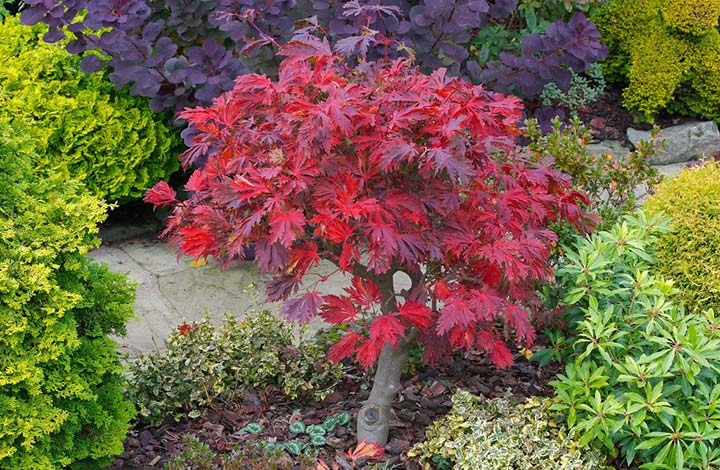

The optimal place for any type of maple is a light, slightly shaded area with moist soil. But the tree will not tolerate stagnant water. Before rooting a seedling, take care of good drainage made from stones, dropout. If the ground, on the contrary, is too dry, the leaves will be covered with a brown border and fall off.
Advice. Protect the maple from drafts in advance by choosing a place for it near the wall, hedge, or by enclosing it around the perimeter of the site with conifers.
Diseases and pests
Maple, whose red leaves are so pleasing to the eye, can become infected with powdery mildew, coral spot. Those shoots that have been affected by parasites should be removed immediately, and the cut sites should be covered with a garden varnish, and then disinfected with special tools. Before the buds develop on the plant, it is worth treating the plants with copper sulfate, and also pollinating with special sulfur.
Such plants are also attacked by phytophages: mealybug, leaf weevil and wedge-shaped whitefly. If there are any parasites on the plant, then it is imperative to spray it even at the stage of feeding larvae. The Actellik remedy is perfect for removing pests. In autumn, the leaves should be collected, and then destroyed.
Maple in the garden
In regions with cold climates, Japanese maples are grown in tubs, which are brought into a cool room for the winter. Growing maples in a tub gives another advantage - the ability to move them, if necessary, in the shade, in the sun or in a place protected from wind, hail and rain.
Since the trees are stunted, in Japan, the tubs with them are placed on a stand so that their wonderful beauty is better visible.
Needless to say, the ornamental tree goes well with other garden dwellers - shrubs, trees, flowers, ornamental grasses. The tree will decorate any corner of the garden - a pond, rockery, stone Japanese garden.
Maples, the leaves of which acquire the greatest decorative effect in the fall, will look good next to autumn flowers - chrysanthemums, oaks, asters. They can be planted next to a tree in order to finally admire the colorful and vibrant beauty of the autumn garden.
Low-growing evergreen shrubs after shearing, for example, boxwood, juniper, ornamental conifers, will become good neighbors for Japanese maples.
As a last resort, you can do without flowers and shrubs - just fill the earth around with colored small gravel or chips.
Probably, there is no gardener who would not try to grow on his site, in addition to useful vegetables and delicious berries, an ornamental plant that can give his backyard its zest. Such prominent representatives of the botanical world include the red Japanese maple - a woody deciduous plant with a gorgeous crown.
Red maple in the garden
Maple red is a hardy plant that is vulnerable to excessive light, as well as drafts and increased soil moisture.
Plants and shrubs affected by poor conditions begin to shed their foliage very early. The branches, as well as the root system, begins to be quickly damaged under the influence of low temperatures, if it is below -15 degrees Celsius in winter.
Maple trees do not like to grow in open, high-light areas that face south. The best place for their growth will be a place protected from drafts, which will have mosaic lighting. All crops work well for an Asian-style garden plot, as well as for general landscaping of a front garden and patio.
Where to plant?
Japanese maple will develop in an ideal location, which must meet the following indicators:
- If you are planting a finger variety, then prepare a shade for it. For everyone else, the sunny side is suitable.
- The soil must be water-permeable. If the right amount of moisture is not supplied to the tree, the leaves will turn brown.
- The place where the maple should grow should not be treated with lime. After contact with the substance, the leaves begin to fall off the bush.
Now you know where and how to plant Japanese maple. Leaving is the next stage of growing an ornamental plant.
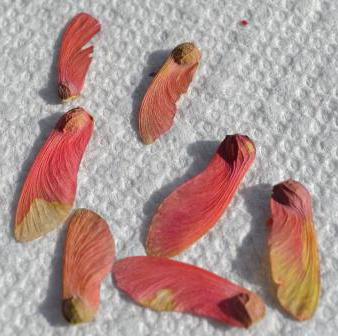

How to grow red maple on the site
Due to its extraordinary decorativeness and docile nature, maple is often used in the landscape design of the Moscow region. Planting and caring for a maple does not cause any particular difficulties, and the return on it is very high. The tree is undemanding to soil and tolerates frost. And if in winter young shoots freeze, in spring it will grow new ones.
Read also: Siberian cedar: what it looks like, where it grows, types of cedar and its cones and seeds
Landscape design studio STROY-GAZON invites you to create a design project for your site, as well as professionally carry out planting and landscaping work.
Elegant foliage attracts attention throughout the warm season. In spring, against the background of blossoming burgundy leaves, inflorescences of small bright yellow fragrant flowers stand out clearly. The grown leaves turn green and acquire the shape characteristic of each species and variety: five-fingered, carved, pointed. There are variegated maples with variegated foliage. Throughout the summer, bright red, pinkish, yellowish-green clusters of lionfish fruits stand out against the background of maple greens. In September, the ripe seeds lose their brightness, but it is then that the leaves begin to change their color.In different species, they are scarlet, yellow, orange, pink, burgundy.
And even the trunks of these trees can be decorative. The Tatar maple has black bark, and the fan maple has greenish, light brown, beige. There are several varieties of snake maple. Their trunks are covered with an unusual "serpentine" pattern: alternating white and green or brown vertical stripes.
Planting and caring for the maple does not include clipping. This is one of the few trees that independently form a beautiful, dense, symmetrical crown. If the plant is not used in a green hedge, it does not need to do formative pruning every year. The trunk grows even and slender, and the fertile shadow of the dense crown saves the adjacent territory from the heat.
Growing from seeds
Organize the collection of seeds in the fall, when they begin to fall. For the next 4 months, keep them in a cool place, where the temperature does not exceed +5 ° C, in a container with moistened sand.
Basic cultivation steps:
- In late April or early May, place the seeds in hydrogen peroxide for 3 days to decontaminate them.
- Mix the soil with sand, peat and humus before planting.
- The depth of the maple seeds is over 3 cm.For planting, use containers 20 cm high and 15 cm in diameter.
- Keep the soil moist for the next time.
The greenhouse effect will help speed up germination. You will be able to see the first shoots after 2 weeks. After the first leaves appear, transplant the plant into open ground. Maple grows slowly, plant care includes 3 steps:
- timely watering;
- loosening the soil;
- weed removal.
Subject to the conditions of planting and care, by autumn the maple sprouts will reach a height of 20–35 cm. After 1–3 years, transplant the seedlings to a permanent place.
A beautiful plant, with careful care, attracts with bright foliage and an unusual trunk. Periodic pruning of branches contributes to the formation of the crown of the desired shape.
Info
Momiji (紅葉)
The Japanese maple (Ácer japónicum) is a species of perennial woody deciduous plants of the Maple genus; it grows in Japan in Honshū, Hokkaidō, Kyūshū, as well as in southern Korea.
Japanese Maples Momiji (紅葉) are exceptionally showy, ornamental trees and shrubs. Even in winter, these deciduous plants captivate the eye with an unusual shape of a bare crown, reminiscent of a mushroom or an umbrella, and many thin weeping branches. However, the beauty of Japanese maples peaks in the fall, when their foliage is painted in vibrant, almost stunning colors.
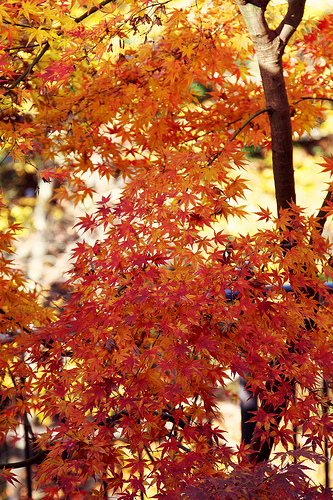

Names in other languages: English. Downy Japanese Maple, Fullmoon Maple, Fin. Hokkaidonvaahtera, fr. érable du Japon, jap.ハ ウ チ ワ カ エ デ ・ 羽 団 扇 楓 (hauchiwa kaede).
The genus of maples (Acer) consists of approximately 110 species of deciduous (rarely evergreen) trees and shrubs that naturally grow in the humid forests of Europe, North and Central America and Asia.
We are talking only about a certain category of maples, which are usually called Japanese (they come from Japan and Korea). This group includes only two species: the Japanese maple (A. japonicum) and the palm-shaped or mountain maple (A. palmatum) with its popular "fan" variety Dissectum, which has dissected, feathery leaves that resemble a lace fan.
Maple was first described in 1784 by Murray from an unpublished work by Thunberg. Since then, many synonyms have appeared in the literature, the most common is Acer circumlobatum Maxim (1867). Its identity, Acer japonicum, was revealed by Koizumi in 1911.
Japanese maples began their triumphant march in European garden culture in the distant 1600s, and by 1882 202 varieties were already known in Britain. Currently, garden centers offer several hundred varieties of Japanese maples, which are primarily distinguished by the color of the leaves, especially impressive in autumn, when maples change dramatically.
The size of Japanese maples depends on the variety: Japanese and palm-shaped maples can reach 8 m in height, while varieties with dissected foliage usually do not exceed 2 m (in rare cases, 4 m at about 25 years old). The latter often grow more in width than in height.
Japanese maple leaves are small and extremely decorative.The color of the leaves is available in all shades of green, burgundy, red, yellow-orange and even pink, and appears best in open, well-lit areas.
Maple flowers are small, yellow-green or reddish, depending on the plant variety. After the end of flowering, small paired lionfish fruits are formed on the plants. Some maples are also decorative with their bark.
An old Japanese legend of the wise emperor and the maple leaves
Long ago, Japan was ruled by an emperor named Takakura no In. He loved nature, plants, and had a particular weakness for maples. Their beauty fascinated, bewitched and pacified him. Takakura no In ordered his gardeners to plant the mountain on top of which his palace stood with all kinds of maples they could find.
Many years passed, the maples grew and the emperor's dream came true. The whole mountain was intricately covered with multi-colored maples that grew in the form of mushrooms, flowerpots or waterfalls, and their fanciful leaves resembled hands, lace fans, and even the strings of an old harp.
Each year, the emperor patiently waited for the fall, when the foliage on his maples took on especially bright colors. Putting all his important affairs of state aside, Takakura no In came to the Upland Palace to admire the carpet of multicolored maple leaves on the ground.
One cold autumn day, a very diligent new gardener was working on the mountain, who knew nothing of the emperor's passion. Trying to make a good impression on the owner, the gardener and his family members raked literally all the fallen maple leaves from the ground and lit a huge fire from them, around which they settled down for the night. And in the morning the courtiers, seeing the bare maples, blackening earth and ash on the mountain, began to seriously fear for the life of the new gardener.
At this time, Takakura no In alone climbed to the top of the mountain to enjoy the long-awaited beauty. Instead of a multicolored tapestry of leaves, his eyes were greeted by a bleak sight of black earth and cold ashes, around which the gardener's family was sleeping peacefully. The emperor understood everything. Contrary to the fears of the samurai, a soft, kind smile suddenly lit up his face.
Takakura no In returned to the palace and wrote a poem about the special gift that maple leaves have: they are able not only to pacify our souls with their exquisite beauty, but also to warm our mortal bodies with their warmth.


In their natural environment, Japanese maples grow in the form of undergrowth, therefore, they are familiar with a high humus content in the soil, partial shade, as well as a more or less constant level of moisture. Japanese maples will grow in any garden as long as the conditions are right for these plants.
Most garden soils are quite suitable for Japanese maples, the only exceptions are strongly alkaline, as well as places with poor permeability and standing water, or completely dry out in the heat.
Another danger trapped by Japanese maples is late spring frosts, which can damage the delicate young leaves. Although, as already mentioned, the color of Japanese maples is best manifested in open spaces with an abundance of light, when choosing a place for planting plants, one should beware of the direct hot sun at midday. Species with bicolored or edged leaves are especially vulnerable to the scorching sun; they must be planted in semi-shady places or places with rare light.
Japanese maples are immune to disease and pests when grown under the right conditions. Weakened plants can be attacked by aphids, weevils and scaly insects, as well as fungal infections.
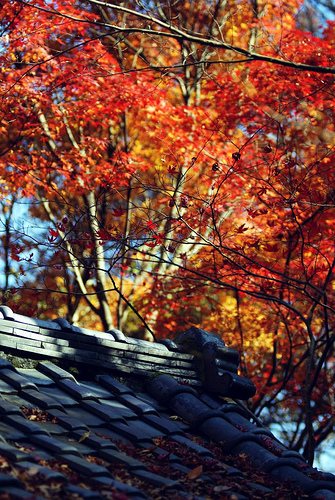

Japanese maples go well with each other. You can create an entire garden of Japanese maples by collecting plants that are suitable in size, shape and color together.You can go further and create a whole Japanese garden by planting shrubs and trees traditional for Japan on a special territory: azaleas, rhododendrons, camellias, keria, magnolia, pieris, hydrangea, witch hazel, stewarty, skimmy, mahonia and maples.
Japanese maples are traditionally planted alongside perennials: hostas, ornamental grasses (whose slender, straight stems create a great contrast to the horizontal style of maples), low ferns and flat, wide clumps of spring and autumn bulbs.
Japanese maples look great in rockeries, near the water, in a bright forest belt, in shrub borders and on mixborers. Japanese maples are used to form topiari and bonsai.
Several subspecies are distinguished, slightly differing in the shape and degree of pubescence of lionfish and leaves; there are many cultivars used in ornamental gardening.
In culture, it is easily propagated by seeds, or by grafting on the palmate maple.
Maples are not only one of the most picturesque, but also the most varied arboreal. Despite the fact that these filigree beauties are found almost all over the world, the most famous of the maples today remain species that symbolize the classic flora of the Land of the Rising Sun. They are related not only by their natural habitat, but also by a unique play of colors, transparency of silhouettes and bewitching watercolors.
How to plant a maple on the site
Several dozen species and varieties of maples are used in landscaping areas. To make a spectacular hedge, you can plant an undersized bush maple on the site. In small areas, in rockeries, mini-gardens, trees about 3 m high are planted.If the area is large enough, the owner chooses large-sized trees with a height of 10 m or more.
The most popular types of maple trees:
Large size:
- Far Eastern
- Manchurian
- Small-leaved
- Holly or Platanus
- Silver
- Sugar
Shrubs or undersized trees:
- Bearded - up to 5 m
- Ginnala or Riverside - up to 5 m
- Tatarsky - up to 7 m
- Ash-leaved - up to 7 m
- Lozhnosibolds - up to 8 m
Maples for the Japanese garden - undersized, long-tiered, with an asymmetric crown and horizontal branching of the shoots:
- Fan-shaped or Hand-shaped
- Three-flowered
Snake species:
- Green-brown
Almost every species was divided by breeders into several varieties, differing in the color of foliage, shoots and bark, crown shape, trunk height. After consulting with a specialist in a landscape studio, you can pick up and plant a maple tree in the country, which is optimal for her in size and shape.
General information with the description of varieties
Japanese maples include the palm maple (Acer palmatum), the fan maple (Dissectum), and the Japanese maple (Acer japonicum), as well as numerous varieties bred on their basis by breeders.
As the name suggests, Japanese maples are native to the Land of the Rising Sun. All of them are distinguished by decorative carved leaves of purple and bright orange colors and shades, and a beautiful structure of the crown.
The sizes of Japanese maples, depending on the species, are from 2-3 meters to 8 meters in height. Palm-shaped maples are taller, and fan-shaped maples are shorter. The flowers are not large in size, they have a yellow-green or red color, which depends on the variety. The seeds of a lionfish grow from the flowers, which scatter over long distances, growing into new trees. Many Japanese maples are distinguished by their decorative crown and bark. Due to these features, the tree becomes a real decoration of the garden or greenhouse.
In addition to the basic varieties, there are many hybrid forms bred in Japan. Each of these forms has a name that conveys the peculiarity of the variety, the main thing is to understand them correctly.
- The Shirasawa maple (Acer shirasawanum) is one of the smallest, about 1.5 meters high. Its leaves are wide, with a border around the edges, yellow-orange in color.
- Bloodgood has a unique ink-black color of the leaves.
- The Beni Kava variety has bright scarlet, light leaves and a fiery red, ruby hue of the bark.
- The Katsura variety has red young leaves that turn green in summer and golden in autumn.
- Nicholsonii has green leaves in summer and brick-red in autumn.
- The variety "Aconitifolium" is multi-stemmed, with curved branches and dark red foliage.
- The variety "Mikawa yatsubusa" is distinguished by its small size - up to 1.5 meters, with a dense, squat crown. Its leaves consist of thin, needle-shaped lobes, bright green in summer and orange-scarlet in autumn.
- Sort "Shino Buga Oka" of low growth, from 1 meter to 1.2-1.3 meters high. The plant is very sprawling, with decorative leaves, bright green in summer and yellow-orange in autumn.
Preparatory work before planting a tree
Before planting a maple on the site, you need to make sure that the grown tree will not become a problem in the future.
An open sunny area should be chosen for the tree in order to get a beautiful lush crown and be able to admire it. The spreading maple growing close to the house can greatly shade the premises. Its shadow will be detrimental to sun-loving flowering perennials and shrubs.
The second possible inconvenience from the maple is the numerous shoots of its seeds. They are carried by the wind and germinate with pleasure on cultivated soil. If there are flower beds or beds in the immediate vicinity, you need to be prepared to deal with additional weeds.
You can plant a maple on a permanent place at the age of 2-3 years, when the tree will show its varietal qualities and become an independent viable organism.
Maple loves fertile soil. If a sufficient amount of humus or compost is prepared for planting, the question of how to grow a maple strong and healthy will be resolved.
It is not difficult when and how to plant a maple so that it quickly takes root and gives an increase. Maple with an open root system is planted in spring or autumn. A seedling grown in container culture can be placed in a permanent place at any time of the year. It is better to plant a krupnomer in winter, when the earthen lump is guaranteed not to crumble from the roots.
Decorative advantages of Japanese maple species
Anyone who admires the autumn decoration of maple has associations with the watercolor landscapes created by the best masters. It is in the final season for all deciduous trees that maples turn into real dominants in any design: even the abundance of bright crowns of classic shrubs and trees in the neighborhood cannot overshadow the beauty of these unique plants. It is no coincidence that maples were named the main symbol of the autumn garden. These not so gigantic trees really seem to have absorbed all the best that autumn nature can offer to the admiring viewer. On cloudy and stormy days, they illuminate whole compositions around them, and on sunny days they glow from the inside and shimmer with joy.
The decorativeness of the maples lies in the amazing beauty of the details with the general nobility and sophistication of silhouettes and forms. After all, the contours of the maple, the shapes of its lush crown and the graceful curves of the branches are no less filigree than the carved leaves. The lines of this plant are an impeccable example of picturesqueness, built on the harmony of naturalness and showiness. In Japanese maples, the crown is tiered or translucent, luxuriantly lacy and almost weightless at the same time. And all the beauty of the mass of foliage only emphasizes the decorativeness of each individual leaf, divided into graceful pointed lobes.
The color palette only crowns, emphasizes and exalts the beauty of the plants themselves, reveals their nobility and elegance. Incredible and rare tones of yellow, orange, red in autumn and in young leaves, and light shades of green or rich dark red in summer in maples are bright, picturesque and pure.Each maple, even representatives of the same variety, has a special and inimitable color. It directly depends on the characteristics of the weather in each year, on the conditions of the place of growth and care. Even in seemingly similar neighboring gardens, two identical maples can be painted in different shades! It will take time for maples to show all their eccentricity: young plants rarely show all their coloristic talents and only in adulthood acquire relative constancy.
At the same time, the bright shades, which, as if by a magic brush, painted the maple leaves by nature, differ not only in flashiness, but also in the effect of internal glow: the transparency of the crowns themselves makes every shade of an almost acrylic "maple" palette completely unique. It is as if the maples that have absorbed the sunlight in the garden have a real magical effect: attracting admiring eyes, they invariably become the center of everyone's attention.
Application in landscape design
Although this foreign plant is not a cheap pleasure, it is very beautiful, therefore it is widely used in landscape design. Recently, a new trendy idea has emerged among tree lovers - a small Japanese garden. All the "salt" is that Japanese maples of various varieties are planted along the alleys, thus arranging a color gradation from golden to blueberry. Such is the small paradise for perfectionism and aesthetics.
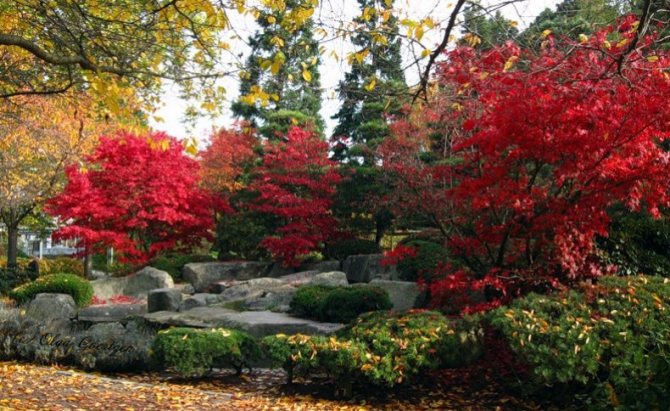

The tree looks great next to ornamental grasses, as well as reservoirs and natural stone, fits well into the landscape of a park or garden. Low-growing varieties of maple can be grown in containers like a common house plant, and in the warm season they can be taken out on the terrace, making it bright and colorful. The stunning landscape can beautify any place all year round. Plant it and enjoy the view!
Japanese maple bonsai. Japanese maple bonsai: buy in "Fitosystems.ru".
In the catalog of our store, various bonsai maple trees are presented, the price of which is lower than in other stores. If the plants of the desired height or the desired variety are not available, you can buy it to order with a short waiting time. We send maple bonsai to different cities, such as: St. Petersburg, Rostov-on-Don, Tver, Vladimir, Nizhny Novgorod, Kostroma, Smolensk, Tula, Sochi, Yekaterinburg, St. Petersburg and many others! Also, you can buy a plant by mail in our online store. Absolutely all plants are carefully packed, and if you buy in winter, the plant is packed with insulation and can easily be transported.
These insects nourish the plant fluids of the plant and the plant fluids of the plant and thus damage the structure of the plant. Symptoms of the presence of cochineal can be recognized, yellowing of leaves, from Knows about stains, from fading of foliage. In the presence of coccinella, remove whitish inlays from branches and spray the plant with specific solutions.
Does outdoor bonsai sound strange to you? We are used to growing bonsai in our homes, but few people know that many of these plants can be cultivated outside, especially during the beautiful season, with excellent results. Together we discover what bonsai are on the outside, what their resistance is and what medicines they need.
But dwarf maple varieties in bonsai are unpretentious and, as it were, help a person with their formation. They do not strive to grow up, but form a dense crown covered with small foliage that preserves its natural appearance.
Agrotechnics of cultivation and care
When cultivating the fan maple in the garden, you should adhere to the basic agrotechnical requirements.
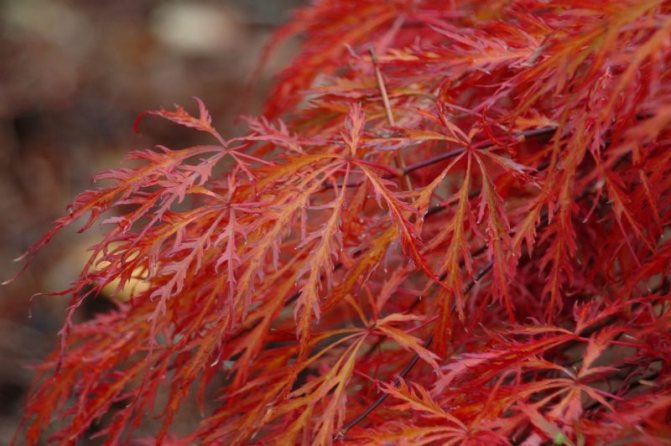

- Watering. The plant loves well-moisturized soil. In the absence of natural rainfall, it is recommended to water the maple every 3 days. During periods of drought, so that the leaves do not begin to dry and fall off, the crown should be sprinkled.
- Loosening and mulching.In the spring, after the establishment of heat, as well as in the middle of autumn, it is necessary to mulch the trunk circle to prevent too rapid evaporation of moisture and freezing of the roots in winter. It is recommended to periodically loosen the soil under the tree to ensure an adequate level of soil looseness and air permeability.
- Top dressing and fertilization. To maintain a fertile soil layer, it is recommended to apply fertilizer to the trunk circle every month during the spring and summer period. Fertilizers are used with a high content of phosphorus and potassium. An excess of nitrogen can cause the culture to lose its decorative effect. A representative of exotic flora responds well to organic fertilizers - compost, humus.
Read also Scinic snail all in one ampoule
Competent selection of seedlings
Since the plant is quite expensive, then the choice of seedlings should be approached carefully. Decide on the variety of Japanese maple: if you have a large area for cultivation, then you can safely stop at large trees (for example, the Shirasawa maple), in the case of a limited area, it is better to buy shrubs.
Seedling recommended to buy in a container, since in this case planting and further care of the Japanese maple will be easier and safer. In addition, the likelihood that the tree will take root is higher, since it will be in its "native" soil and its root system will not suffer during planting.
It is worth buying maple in a special store. It should have a fresh, healthy appearance, without limp leaves or any damage.
Conditions for growing maple bonsai
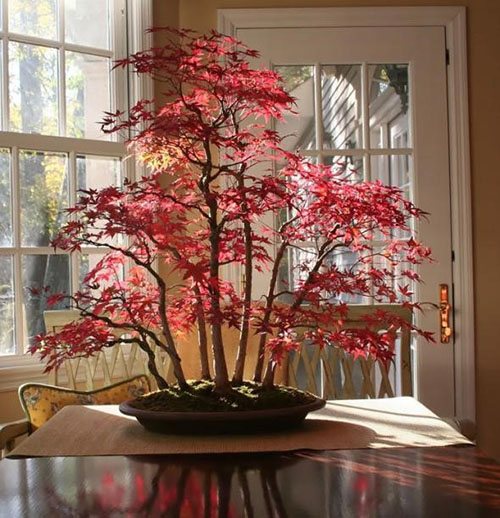

Maples feel good in central Russia, but as a bonsai, this tree suffers more from external influences and needs a careful choice of place of residence.
The most common maples in bonsai, palm-shaped and fan-shaped maples, can be sore and have difficulty growing:
- in direct sunlight, especially in the southern regions;
- in the wind or drafts;
- in thick shade.
However, when it comes to choosing between light and shade, it is better to expose the pot to the sun, which in the central part of the country will not cause serious harm. In the sun, the tree forms smaller leaves, which eliminates the need to remove buds and does not weaken the plant. In addition, the colors of the foliage in full sun are brighter and more attractive.
If in the summer, as in the photo, the maple bonsai is taken out into the open air, it must be protected from the wind, otherwise a plant with a trimmed root system risks losing its balance and falling out of a shallow pot.
Maples, both in nature and at home at low temperatures, do not tolerate excessive humidity and insufficient supply of fresh air. In such conditions, bonsai is attacked by harmful fungi that cause powdery mildew and anthracnose.
Watering is a must and very important part of bonsai maple care. In summer, the intensity and frequency are increased, if necessary, careful sprinkling is used. In winter, when the leaves fall and the plant hibernates, the need for moisture drops sharply.
In the spring, with the awakening of the maple, they feed it, and the presence of iron in the mixture is important for the maple. This is also taken into account when compiling the substrate. Soil for maple bonsai should be nutritious, aerated, with a neutral or slightly acidic reaction. In addition to traditional components, a clay substrate for bonsai is added to the soil, which provides anchoring of the root system and structuring the earth mixture.
Transplanting and replacing the container when growing maple bonsai coincides with root pruning, which is carried out at intervals of 2-3 years. In parallel with the formation, dead or damaged rhizomes, lumps of adhered soil are removed.
Collecting and planting seeds
The Japanese maple is propagated by seeds, which are harvested in the month of October. They are stratified in preparation for planting.Then they are laid out in sandy dry soil, stored in a cool room.
In early spring, planting material is treated with a growth stimulant and sown in special containers... Over the summer, the seedlings grow well, after which they are sorted, leaving tall and strong sprouts. Seedlings grown from seeds should remain indoors in their containers for their first winter. Then they are transplanted into pots, each one separately. When the plants grow, they are planted outdoors.
Japanese fan maples: pruning
Japanese maples grow slowly and naturally form a beautiful and harmonious crown. Pruning is only recommended for mature or old plants to thin out over-thickened crowns or to accentuate the delicate shape of the trunk and weeping branches of the Japanese maple. Thinning the crown of Japanese maples also promotes the penetration of light and air into the depths and is the prevention of fungal infections. Pruning Japanese maples is done only during the dormant period, when there are no leaves on the plant.
Maple bonsai crown shaping techniques
How to grow maple bonsai without pruning and pinching the crown? It's impossible. These techniques, along with wire-forming stems, are an integral part of ancient art.
Pruning of branches is carried out when up to five pairs of full leaves are revealed on the shoot. Usually they are shortened by 2-4 leaves, and large leaf plates are plucked out separately, leaving their cuttings.
Over time, the cutting will fade and fall off, and too large leaves will be replaced by small ones, more appropriate for bonsai. In the middle of summer, healthy trees with green foliage undergo defoliation or plucking of growth buds, which will lead to:
- to growth retardation;
- to the gradual formation of shorter shoots;
- to increase the density of the crown.
On red maples for bonsai, this operation is not performed, as it can weaken an already sensitive plant.
It is better to carry out all procedures related to pruning not in spring, when sap flow is active, but in summer or autumn. The same applies to artificial aging of maples grown for bonsai. In the second half or at the end of the growing season, the inflicted wounds heal better, and the tree recovers better.
Japanese Palm Maple Bonsai - video
Maples with colorful foliage are very popular among ornamental trees. Japanese maple is distinguished not only by red leaves, but also by an unusual crown, which has many thin branches. This becomes noticeable in winter when the branches are bare. Let us consider in more detail the characteristic features of the plant.
Working with a handle
A quicker way to create a maple bonsai with your own hands is to take a finished tree stalk and transform it.
- A blank twig is prepared in early summer: they choose the one they like, it should not have a formed bark.
- At the base of the cutting, an annular cut of the skin and rough woody part is made. Roots will develop here. The second same incision is made 2-3 cm higher than the first.
- Remove the bark and the hard part between the incisions.
- A root-forming hormone is applied to the cut area in the form of a powder or gel.
- To activate the work of the substance, moistened sphagnum moss is attached to the treated cut, sealed with polyethylene and left in a dark, cool place.
- After a few weeks, the roots will show themselves through the applied protection, then the bandage can be removed.
For germination, you can use a mixture of good compost and sand: the cut part of the cutting is placed in a moistened substance until roots appear.
After the formation of confident roots, the cutting is separated from the mother branch.
Escape landing
They take a pot with drainage holes, fill it with round pebbles, soil (80% crushed bark and 20% peat) in an amount sufficient to securely fix the tree. A thin bark is removed from the shoot, without violating the integrity of the roots, the bare part is placed in the ground.
A little sphagnum moss can be added to the soil. It fertilizes and softens hard water for gentle root care.
To enhance the fixation, a peg is inserted into the pot, to which a young tree is tied.
Do-it-yourself cultivation of bonsai by cuttings is available only in cases where the tree is planned to be placed on the street. Even full care is not able to replace the native element for a wild tree. During the period when the color of the foliage changes, the composition can be brought into the house, but not more than for 1-2 hours.
Wintering plants
Japanese maple is an extremely thermophilic plant, which is why winter is quite stressful for it. To protect the shrubbery from freezing, it is worth performing a set of actions:
- in late autumn, lay a layer of mulch 10-13 cm thick around the root system;
- at the time of low temperatures, it is better to insulate the tree trunk with coniferous spruce branches;
- remove frozen branches in spring.
If you follow all the rules, your plant will overwinter very successfully.
Red Japanese Maple in the Landscape: Planting and Care
Japanese maple is a perennial ornamental tree grown in the Land of the Rising Sun. Large lobed leaves are green in summer, and in autumn their color changes to an unusual red. He is rarely seen in our latitudes. But, having seen this tree, you will not resist the temptation to have it in your garden or summer cottage.
Maple attracts attention with its unique look. In order for it to please you for a long time, you need to carefully study the recommendations for growing and caring for the tree.
Description of varieties
The culture is represented by three basic varieties and many hybrid bred.
Basic varieties:
- Japanese.
- Japanese fan-shaped.
- Palm-shaped.
They differ in the shape of the leaves, their varied colors and the shape of the crown.
- Japanese maple. The plant is suitable for greenhouses or places with warm climates. Absolutely frost-resistant. It is characterized by graceful leaves. They change color over the course of their existence: from green in spring to autumn yellow and red shades.
- Japanese fan-shaped. These are low trees with an unusual crown. Lacy leaves, shaped like a fan, are characterized by a red or golden color scheme.
- Palm-shaped.
The most beautiful plant in the Japanese maple family. Interestingly, the shape of the leaves, similar to a palm, having from 5 to 9 "fingers". They have a burgundy color throughout the warm period. The culture grows slowly, reaches 5 meters in height, the crown is 3 meters in diameter.
Of the hybrid varieties, the following trees are especially common:
- Shirasawa. Low-growing species, no more than one and a half meters. The yellow-orange leaves have a dark edging.
- Bloodgood has an ink-colored foliage.
- The variety "Beni Kava"
ruby bark and red leaves
. - Shino buga oka,
dwarf species of one meter height. The tree is very spreading. The foliage changes color from bright green in summer to yellow orange in autumn.
Maple propagation for bonsai
All types of this plant are easily propagated by cuttings and rooted cuttings. For growing from maple bonsai, seeds are also suitable, which should be stratified before sowing.
To do this, the seed is dropped into wet sphagnum, sand or, after which the container with the seeds is sent to the refrigerator. For preparation of seeds of palm-shaped maple, for example, 3-4 months stay in the department for vegetables is enough. The field of this, when warmed, the shell will surely open, and friendly shoots will appear on the light.
The hatched maple seeds for bonsai are transferred into a sand-peat mixture or planted in well-moistened peat tablets. In a greenhouse in the light, but not in direct sunlight, the plants give a pair of true leaves after a month.
When their number reaches 4-5, it's time to transfer young maples to their own pots and start forming bonsai.
Planting recommendations
Planting and care must strictly follow the growing instructions. Otherwise, you are unlikely to be able to grow a healthy and beautiful plant.
The ideal place for Japanese maple is partial shade, as the leaves can get burned under the bright rays of the sun. The soil for planting must be drained.
The Japanese plant loves humus-filled, slightly acidic soil. To make it strong, the ground around it needs to be fertilized once a month in spring and summer; in winter, no top dressing is done.
In the event that the seedling is planted in fertile land, one feeding will be enough for a whole year. If the soil is scarce, then the tree must be fertilized a second time in the summer and only until August; after this, fertilizers cannot be applied to the soil, since the plant needs preparation for winter.
Japanese tree is very fond of water... A young seedling must not only be watered, but also given a large amount of water. In the summer, it is watered once every seven days, in the cold season - once a month. When you have finished watering, pluck out all the weeds and loosen the soil around the tree so that the soil is not very compacted. With poor watering, the tree grows very slowly.
The method of planting a maple seedling is simple, you just need to remember some rules. For the correct planting of a Japanese tree, you need to prepare in advance:
- healthy seedling;
- peat and compost for soil fertilization.
The size of the pit should be twice the span of the seedling's roots. Carefully untangle the roots before planting the tree. Lower the peat and compost into the dug hole, then carefully immerse the seedling and cover it with earth on top, lightly tamping it.
Make bumpers around the seedling, this will retain moisture. Fill well with water so that the root system takes over faster. In hot weather, water maple more often and abundantly. It is very important that the roots of the maple receive moisture in full, otherwise the leaves from its lack will have an unattractive brown color. The tree does not like lime: if the roots come into contact with it, the maple will shed its foliage.
Spread a mulch layer of soil on top, mixed with rotten leaves. This is an excellent protection against weeds, and moisture will retain well in the root circle.
Read also: Veronica - popular plant species, reproduction, care and use in medicine
Searching for seeds
Most often, gardeners use a mature tree seed - later, such a source can be given any shape without the need to change an already formed system.
Harvesting is carried out after ripening and falling of "helicopters" from the branches in the autumn. True, such material is not ready for planting: for seeds it is necessary to arrange an imitation of winter rest in artificial conditions. To do this, take a container with a tight-fitting lid, put wet sand in it, into which the seeds are buried, close the container and place it in the refrigerator. The stratification period is 100-120 days, in the spring the collection is ready for planting.
If you want to grow a natural decor item at home, but there is no time to collect seeds, you should contact specialized stores that offer ready-made planting material for Japanese and other types of maple. Blue, blue, red bonsai are obtained only from specially bred plants.
A faster way to get an ornamental tree is to plant a cutting.
Preparation of planting material
In order for the seeds to grow faster, a dense shell is incised and placed in warm water or 9% hydrogen peroxide for 2-3 days. In conditions of high humidity, the liquid is intensively absorbed and the seed comes to life.
To prevent the development of diseases of the embryo of a tree, primary seed treatment is carried out with a dry or liquid fungicide.
Preparing the soil and capacity
To grow maple bonsai at home, it is important to properly prepare the soil. For maple, an equal ratio of alumina, humus and sand is taken.
An important stage is soil disinfection. Optimal ways:
- Heat treatment with high temperatures. To do this, the soil is heated in an oven, microwave or in a water bath, then cooled, dried and sieved through a sieve.
- Another method is freezing and thawing the soil.
- The use of dietary supplements such as "Fitosporin", "Barrier", etc. They are sold in specialized flower shops.
During processing, pathological fungi, mold, insect eggs and other infection that can harm the plant die. After the procedure, fertilizer is introduced into the soil to restore beneficial microflora.
For the first time, you can take a small bonsai tree - the tree is grown no faster than in natural conditions, therefore, as it grows, it is changed to a larger volume.
The container is thoroughly cleaned with non-aggressive substances, washed and dried. There must be drainage holes in the bottom of the pot. To avoid washing out the soil, it is recommended to cover the bottom with a net.
Planting seeds
Soil is poured into the prepared container, leaving 3 cm to the edges of the bonsai. If there are several seeds, they are placed at a distance of at least 1 cm from each other. The resulting layer is pressed with a board, then soil is poured on top with a thickness of no more than 3 diameters of seeds. The planting is lightly watered and the container is covered with glass or polyethylene for free passage of light and moisture retention.
After the first shoots appear, the glass is raised, and several holes are made in the film to supply fresh air.
After the formation of leaves, young shoots are planted in fresh soil at a distance of 2-3 cm.
General characteristics
Today there are about 100 types of wood. The plant is easy to recognize by the following criteria:
- bush or tree with foliage;
- the height can be from 2 to 10 meters, depending on the variety;
- small leaves of a bright shade;
- allowed colors: green, yellow, fiery red, pink;
- the shape of the leaf resembles a palm tree;
- during flowering, small flowers are formed.
Japanese maple is suitable for people who love the autumn mood and its exuberant colors. There are many varieties of such a tree, it is worth mentioning separately some important varieties.
Wood care tips
Care and planting are individual for each type of plant. Many of them prefer the sun, but at the same time they do not like direct sultry rays. This does not apply to those trees that have a double color on the leaves - they prefer shade. Keep in mind:
- Japanese maple is not afraid of drafts and strong winds. If the climatic conditions in your area are cold, then the tree should be carefully covered for the winter. The ideal material for warming maple is a soft and warm garden fleece.
- In winter, shake off the snow from the branches, as they can break from the severity. Do not touch the branches covered with an ice crust after the winter thaw, they are easy to damage.
- When forming the crown of a maple, the branches must be cut off at the beginning of growth, then only diseased and damaged parts must be cut off.
In the case when the crown of the tree becomes very dense and its appearance is no longer so attractive, you need to prune it. This is done as soon as the tree drops its foliage. This will return transparency to the crown and save the plant from getting a fungal infection.
Benefits of propagation with seedlings
Not every variety of a plant such as the Japanese maple retains its own extraordinary decorative characteristics during propagation with the help of seeds. At the same time, it matters for them in what conditions the plant should grow. Therefore, it is generally accepted to propagate this plant using cuttings, grafts and mutations. There are varieties of it grown only in Japan. If the summer resident wants to grow some varieties from the seeds of Japanese maple, then it is better to grow from seedlings, because in this case he is able to discern the features of the tree.Although the seeds can also become different and change the leaf or something else. Pictures show how to grow these varieties from seedlings.
Pictures are an illustration of Japanese maple leaves
Care for the Japanese maple and for each of its species should be different (wikipedia), for example, caring for one variety may involve watering, and for some, such a process is categorically unnecessary, as you can see in the picture. For example, the fan-shaped variety loves the sun, but the palm-like variety, on the contrary. At the same time, the fan can be planted in any well-lit area of the garden. This plant has a small root system. Therefore, it can be planted near other trees in the garden, near the building, near the fence. The seedlings of this plant do not need to be fertilized, as the seeds may die from an excess of fertilizer. In this case, the seeds can be planted in loose soil.
Japanese maple varieties
The red maple of the Kiyohime species, like the palm-shaped one, has the following description: it is about 1.5 meters tall, has a green leaf with a red border. This plant is a slow growing bush. Seeds are best planted in shaded areas of the garden. The seeds of this plant can withstand temperatures in the winter of about -28 degrees. Consider the description of the species Aka shigitatsu sawa, which is very similar to the palm-shaped variety in the picture: it has a pinkish dissected leaf, which has green veins. This tree grows to about three meters in height. It is better to plant its seedlings in sunny areas of the garden.
Another species - this red Japanese maple variety is a shrub that grows to about 2.3 meters in height, like palm-shaped. At the same time, palm-like in the autumn, like this variety, has a fan-shaped orange leaf. The small plant grows well in sunny areas of the garden or in semi-shady areas. They can grow even in minus 15 degrees below zero. You need to plant this plant in the picture like any other Japanese ornamental plant.
As shown in the picture, if the plant is exposed to some kind of pest and the leaf becomes dull, then you need to cut out the dead branches to the area where the wood is healthy. It is necessary to disinfect the device after any sections. During the summer, every leaf and bark of the planting should be inspected from time to time. If you find signs of a disease on the leaves or other place of the plant, then you need to use different means to combat such pathogens. As shown in the photo, fungal diseases need to be fought with the use of drugs that contain sulfur.
The Japanese maples in the picture are great for small backyards. As a tapeworm, this beautiful plant can attract the attention of everyone and among lawns, and near a reservoir, and in front gardens, and in rock gardens or on terraces. Maple is a great bonsai tree. At the same time, bonsai with its use can turn out to be elegant and beautiful. Bonsai can be created in partial shade near the edge of shrubs. In such protected areas, the plant grows well and creates a beautiful foreground. It is not necessary to plant a shrub in autumn densely so that the crown can grow and develop at the same time.
Bonsai from japanese maple
Japanese maple is also used by many designers for planting on rooftops. Low species can be planted in tubs or troughs. These beautiful shrubs can also be used to form in the bonsai style. The bonsai style is very popular today, and bonsai can be of any kind. Such plants can be happily placed in a protected area, for example, in the edges of forest stands or under shrubs.
They have a rather variegated color in the autumn, evergreen conifers, for example, juniper, look very impressive on a monochromatic combination. An excellent solution are other classic planting varieties that grow along the edges of forests, for example, ferns or hosta. Other plants can be planted under tall maples.Under their light crown, flowers such as fragrant violets and other beautiful plants that can decorate your backyard will feel great.
Planting and leaving
In order to grow this plant in your personal plot, you need to purchase Japanese maple seedlings in a special container or compost. To plant a plant, do the following:
- We dig a groove. And we bury the seedlings in a hole twice the size of the seedlings themselves. The soil needs to be mixed with a lot of peat and compost.
Japanese maples are considered to be the most decorative and spectacular trees. In summer and autumn, they fascinate with the beauty of their leaves, and in winter - with an unusual crown structure, with a great many thin branches.
Breeding methods
Propagating a plant is not that difficult on your own.
Mostly use 2 ways to breed maples:
- Seeds. But when planting by seed, the seed necessarily requires preliminary start-up. This procedure can be carried out in artificial conditions if the seeds are placed in the refrigerator. They should lie there for at least a quarter, while the temperature in the refrigerator should be from 0 to +4 degrees. But it can be organized in natural conditions. To do this, in the autumn period, it is necessary to collect ready-made impellers from the bush, which then break off. Each of the halves contains a seed. This seed is placed not too deep into the soil - 3-5 cm, after which, after a while, sprouts appear. It is recommended to cover young sprouts for the winter, and with the arrival of spring days, they will begin to develop further, and the most powerful, strongest can be selected and planted around the site
- Used for propagation in industrial production by cuttings and grafting on ready-made root systems.
When planning the cultivation of maple, it is necessary to take into account the fact that it likes to grow in well-lit areas, quite picky about the composition of the soil: prefers rich soil mixtures with a good nutrient medium, very poorly tolerates sandy and stony soils, too dense soils.
Wood needs thorough and regular hydration... But watering should be moderate so that moisture does not stagnate in the soil. You also need a good drainage layer. For this, expanded clay, crushed stone or broken brick is suitable.
Popular species and varieties
Breeders count about a hundred different species and varieties of this exceptionally spectacular, but very whimsical guest of the Russian garden. A huge variety of types of red maple allows you to choose the optimal variety and color scheme of foliage for absolutely any landscape solution. The following types of maple are in greatest demand:
Today florists-decorators offer an extraordinary solution - to plant an undersized Japanese maple on the roof of a building. Someone will like such a creative idea. Also, bonsai-style compositions are made from ornamental shrubs of Japanese maple.
Trees, the foliage of which opens up in full glory in the fall, look good next to flowers such as gerberas, asters, dahlias. They are planted near the maple tree so that the autumn garden sparkles with new colors.
It is not bad if stunted evergreen shrubs (spirea, holly, boxwood) or ornamental conifers (juniper, larch, cypress) grow next to such a maple. At worst, if it is not possible to plant flowers and shrubs, the soil in which the maple is planted is sprinkled with small colored pebbles or chips.
Despite its exotic and original appearance, Japanese red maple is successfully grown even in seemingly completely unsuitable climatic conditions.
Adhering to the advice of gardening experts, you can easily grow a beautiful tree on your site and thereby add a bright spot to the landscape outside the window.
Maple Japanese garnet. Description
Maple Katsura (Acer Palmatum ‘Katsura’, Acer palmatum var. Dissectum ‘Katsura’). Maple "Katsura" pleases with very bright yellow foliage. Therefore, this tree will become a real decoration for any garden, but especially for an oriental-style landscape (gravel garden, pond bank, in the middle of the lawn, etc.). It looks especially impressive against shrubs such as juniper or yew, and is also suitable for composition with azaleas and rhododendrons in the undergrowth. He is loved for the shape of the crown and leaves. Its beauty will not leave you indifferent either! This plant is also called in another way: Japanese maple or palm-shaped maple. It is a slow-growing shrub or small tree that usually grows up to 1.5-6 m in height. The width of the plant is 1.5-4 m. Its homeland is Japan, Korea and China. IE Kharchenko gives you the opportunity to order Japanese maple seedlings, which will give you joy and warmth.
Katsura is a compact, undersized variety. It is better known for its beautiful spring foliage. Small, palmate, 5-lobed leaves up to 2.5 cm long. They appear yellow-green in spring with orange-tinted edges. In summer they are bright green and their border turns pink. And finally, in autumn, they acquire pastel shades of orange and yellow. The lobes of the leaves are lanceolate, with fine tips and small jagged edges. The flowers of the fan maple are small, reddish in color, collected in panicles. They appear in the spring, from April to May. They are attractive on closer inspection, but not cast from a distance. The lionfish fruit ripens in September-October. Lionfish are first red and then turn gray. This variety, as a rule, has a transparent umbrella-shaped crown. It grows up to 4 m in height during the first 10 years, and gradually becomes more rounded with age. It grows slowly and when it reaches only about 2 m in height, then it begins to spread its branches to the sides. This results in almost the same size in height and width. Pruning is not required for the plant, but many growers choose to shape it. The small, reddish flowers are somewhat attractive on closer inspection, but not flashy from a distance.

